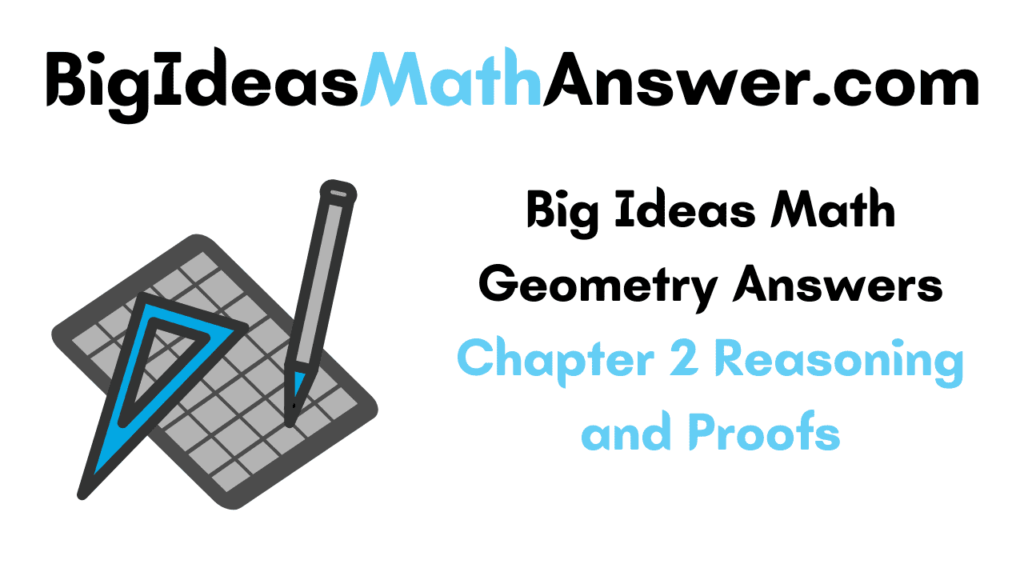Reasoning and Proofs Chapter Answers provided are aligned as per the Big Ideas Math Geometry Textbooks. Have an overview of the concepts you need to learn in BIM Geometry Ch 2 Reasoning and Proofs and test your understanding. Master the topics of BIM Geometry Chapter 2 Reasoning and Proofs by practicing from the quick links available below. Identify the knowledge gap and concentrate on the areas you are lagging and improvise on them accordingly. You will find the Big Ideas Math Geometry Answers and attempt the exam with utmost confidence.
Big Ideas Math Book Geometry Answer Key Chapter 2 Reasoning and Proofs
Become proficient in the concepts of BIM Geometry Chapter 2 Reasoning and Proofs by referring to the quick links available. Solve the Questions available in BIM Book Geometry Chapter 2 Reasoning and Proofs Answer Key on a frequent basis and get a good hold of the concepts. Geometry Big Ideas Math Chapter 2 Reasoning and Proofs Answers here include questions from Lessons, Review Tests, Cumulative Practice, Assessment Tests, Practice Tests, etc. aligned as per the Textbooks. Download the Big Ideas Math Book Geometry Ch 2 Reasoning and Proofs Solution Key for free of cost and ace your preparation.
-
- Reasoning and Proofs Maintaining Mathematical Proficiency – Page 63
- Reasoning and Proofs Mathematical Practices – Page 64
- 2.1 Conditional Statements – Page(65-74)
- Lesson 2.1 Conditional Statements – Page(66-70)
- Exercise 2.1 Conditional Statements – Page(71-74)
- 2.2 Inductive and Deductive Reasoning – Page(75-82)
- Lesson 2.2 Inductive and Deductive Reasoning – Page(76-79)
- Exercise 2.2 Inductive and Deductive Reasoning – Page(80-82)
- 2.3 Postulates and Diagrams – Page(83-88)
- Lesson 2.3 Postulates and Diagrams – Page(84-86)
- Exercise 2.3 Postulates and Diagrams – Page(87-88)
- 2.1 – 2.3 Study Skills: Using the Features of Your Textbook to Prepare for Quizzes and Tests – Page 89
- 2.1 – 2.3 Quiz – Page 90
- 2.4 Algebraic Reasoning – Page(91-98)
- Lesson 2.4 Algebraic Reasoning – Page(92-95)
- Exercise 2.4 Algebraic Reasoning – Page(96-98)
- 2.5 Proving Statements about Segments and Angles – Page(99-104)
- Lesson 2.5 Proving Statements about Segments and Angles – Page(100-102)
- Exercise 2.5 Proving Statements about Segments and Angles – Page(103-104)
- 2.6 Proving Geometric Relationships – Page 105
- Lesson 2.6 Proving Geometric Relationships – Page(106-114)
- Exercise 2.6 Proving Geometric Relationships – Page(111-114)
- 2.4 – 2.6 Performance Task: Induction and the Next Dimension – Page 115
- Reasoning and Proofs Chapter Review – Page(116-118)
- Reasoning and Proofs Test – Page 119
- Reasoning and Proofs Cumulative Assessment – Page(120-121)
Reasoning and Proofs Maintaining Mathematical Proficiency
Write an equation for the nth term of the arithmetic sequence. Then find a50.
Question 1.
3, 9, 15, 21, ……..
Answer:
an = a1 + (n – 1)d
a1 = 1
d = 6
d = the difference between the two numbers
a1 = first number in the series
a50 = 3 + (50 – 1)6
= 3 + (49)6
= 3 + 296 = 299
Question 2.
– 29, – 12, 5, 22, ……..
Answer:
an = a1 + (n – 1)d
a1 = -29
d = 17
d = the difference between the two numbers
a1 = first number in the series
a50 = -29 + (50 – 1)17
= -29 + 833
= 804
Question 3.
2.8, 3.4, 4.0, 4.6, ………
Answer:
an = a1 + (n – 1)d
a1 = 2.8
d = 0.6
d = the difference between the two numbers
a1 = first number in the series
a50 = 2.8 + (50 – 1)0.6
= 2.8 + 29.6
= 32.4
Question 4.
\(\frac{1}{3}, \frac{1}{2}, \frac{2}{3}, \frac{5}{6}\), ………
Answer:
an = a1 + (n – 1)d
a1 = \(\frac{1}{3}\)
d = 0.16
d = the difference between the two numbers
a1 = first number in the series
a50 = \(\frac{1}{3}\) + (50 – 1)0.16
= \(\frac{1}{3}\) + (49)0.16
= 8.17
Question 5.
26, 22, 18, 14, ………
Answer:
an = a1 + (n – 1)d
a1 = 26
d = -4
d = the difference between the two numbers
a1 = first number in the series
a50 = 26 + (50 – 1)-4
= 26 + (-196)
= -170
Question 6.
8, 2, – 4, – 10, ………
Answer:
an = a1 + (n – 1)d
a1 = 8
d = -6
d = the difference between the two numbers
a1 = first number in the series
a50 = 8 + (50 – 1)(-6)
= 8 + (-294)
= -286
Solve the literal equation for x.
Question 7.
2y – 2x = 10
Answer:
Given equation
2y – 2x = 10
2(y – x) = 10
y – x = 10/2
y – x = 5
x – y = -5
x = -5 + y
Question 8.
20y + 5x = 15
Answer:
Given equation
20y + 5x = 15
5(4y + x) = 15
4y + x = 15/5
4y + x = 3
x = 3 – 4y
Question 9.
4y – 5 = 4x + 7
Answer:
Given equation
4y – 5 = 4x + 7
4y – 4x = 7 + 5
y – x = 3
x – y = -3
Question 10.
y = 8x – x
Answer:
Given equation
y = 8x – x
7x = y
x = y/7
Question 11.
y = 4x + zx + 6
Answer:
Given equation
y = 4x + zx + 6
y – 6 = 4x + zx
y – 6 = x(4 + z)
x = (y – 6)/(4 + z)
Question 12.
z = 2x + 6xy
Answer:
Given equation
z = 2x + 6xy
z = x(2 + 6y)
z/(2 + 6y) = x
Question 13.
ABSTRACT REASONING
Can you use the equation for an arithmetic sequence to write an equation for the sequence 3, 9, 27, 81. . . . ? Explain our reasoning.
Answer:
3, 9, 27, 81
3, 3², 3³, 34
The equation is 3n
Its not an arithmetic sequence it is a geometric sequence.
Reasoning and Proofs Mathematical Practices
Monitoring Progress
Decide whether the syllogism represents correct or flawed reasoning, If flawed, explain why the conclusion Is not valid.
Question 1.
All triangles are polygons.
Figure ABC is a triangle.
Therefore, figure ABC is a polygon.
Answer:
Yes, all the triangles are examples of polygons the name itself tells how many sides the shape has.
Thus all the triangles are polygons.
Question 2.
No trapezoids are rectangles.
Some rectangles are not squares.
Therefore, some squares are not trapezoids.
Answer:
No, all the squares are not trapezoids.
A trapezoid is a quadrilateral with at least one pair of parallel sides.
In square there are always two pairs of parallel sides.
Question 3.
If polygon ABCD is a square. then ills a rectangle.
Polygon ABCD is a rectangle.
Therefore, polygon ABCD is a square.
Answer:
Yes, Polygon ABCD is a square.
Question 4.
If polygon ABCD is a square, then it is a rectangle.
Polygon ABCD is not a square.
Therefore, polygon ABCD is not a rectangle.
Answer:
No, Polygon ABCD is not a rectangle.
Polygons are plane figures made up of line segments.
2.1 Conditional Statements
Exploration 1
Determining Whether a Statement is True or False
Work with a partner: A hypothesis can either be true or false. The same is true of a conclusion. For a conditional statement to be true, the hypothesis and conclusion do not necessarily both have to be true. Determine whether each conditional statement is true or false. Justify your answer.
a. If yesterday was Wednesday, then today is Thursday.
Answer: Yes the statement is true.
b. If an angle is acute. then it has a measure of 30°.
Answer: False
c. If a month has 30 days. then it is June.
Answer: 30 days has September, April, June and November. The statement is false.
d. If an even number is not divisible by 2. then 9 is a perfect cube.
Answer: False, All even numbers are divisible by 2,9 is not a perfect cube.
Exploration 2
Determining Whether a Statement is True or False
Work with a partner: Use the points in the coordinate plane to determine whether each statement is true or false. Justify your answer.

a. ∆ABC is a right triangle.
Answer: True

b. ∆BDC is an equilateral triangle.
Answer: True

c. ∆BDC is an isosceles triangle.
Answer: False

d. Quadrilateral ABCD is a trapezoid.
Answer: True

e. Quadrilateral ABCD is a parallelogram.
Answer: False
Exploration 3
Determining Whether a Statement is True or False
Work with a partner: Determine whether each conditional statement is true or false. Justify your answer.
CONSTRUCTING VIABLE ARGUMENTS
To be proficient in math, you need to distinguish correct logic or reasoning from that which is flawed.
a. If ∆ ADC is a right triangle, then the Pythagorean Theorem is valid for ∆ADC.
Answer: Yes it is a correct logic.
b. If ∠A and ∠B are complementary, then the sum of their measures is 180°.
Answer: No
c. If figure ABCD is a quadrilateral, then the sum of its angle measures is 180°.
Answer:
d. If points A, B, and C are collinear, then the lie on the same line.
Answer:
e. It ![]() and
and ![]() intersect at a point, then they form two pairs of vertical angles.
intersect at a point, then they form two pairs of vertical angles.
Answer:
Communicate Your Answer
Question 4.
When is a conditional statement true or false?
Answer:
The logical connector in a conditional statement is denoted by the symbol. The conditional is defined to be true unless a true hypothesis leads to a false conclusion
Question 5.
Write one true conditional statement and one false conditional statement that are different from those given in Exploration 3. Justify your answer.
Answer:
True conditional statement:
If ∠A and ∠B are vertical angles, then they are equal.
False Conditional statement
If all the sides of a quadrilateral are equal, then the sum of its angles measures is 180 degrees.
Lesson 2.1 Conditional Statements
Monitoring Progress
Use red to identify the hypothesis and blue to identify the conclusion. Then
rewrite the conditional statement in if-then form.
Question 1.
All 30° angles are acute angles.
Answer: If an angle measures 30°, then it is acute angle.
Question 2.
2x + 7 = 1. because x = – 3.
Answer: If x = -3, then 2x + 7 = 1
In Exercises 3 and 4, write the negation of the statement.
Question 3.
The shirt is green.
Answer: The shirt is not green
Question 4.
The Shoes are not red.
Answer: The shoes are red
Question 5.
Repeat Example 3. Let p be “the stars are visible” and let q be “it is night.”
Answer:
p → q If the stars are visible, then it is night True
q → p If it is night, then the stars are visible False
∼p → ∼q If the stars are not visible, then it is not night False
∼q → ∼p If it is not night, then the stars are not visible True
Use the diagram. Decide whether the statement is true. Explain your answer using the definitions you have learned.
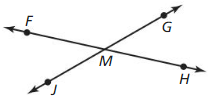
Question 6.
∠JMF and ∠FMG are supplementary.
Answer: True. They are a linear pair
Question 7.
Point M is the midpoint of \(\overline{F H}\).
Answer: False. There is no marking to show \(\overline{F H}\) ≅ \(\overline{M H}\)
Question 8.
∠JMF and ∠HMG arc vertical angles.
Answer: True. They share a vertex and their sides for, opposite rays.
Question 9.
![]()
Answer: False. You cannot assume their intersection is a right angle without markings.
Question 10.
Rewrite the definition of a right angle as a single biconditional statement.
Definition: If an angle is a right angle. then its measure is 90°.
Answer: An angle is a right angle if and only if its measure is 90°.
Question 11.
Rewrite the definition of congruent segments as a single biconditional statement.
Definition: If two line segments have the same length. then they are congruent segments.
Answer: Two line segments are congruent if and only if they have the same length.
Question 12.
Rewrite the statements as a single biconditional statement.
If Mary is in theater class, then she will be in the fall play. If Mary is in the fall play. then she must be taking theater class.
Answer: Mary will be in the fall play if and only if she is in theater class.
Question 13.
Rewrite the statements as a single biconditional statement.
If you can run for President. then you are at least 35 years old. If you are at least 35 years old. then you can run for President.
Answer: You can run for president if and only if you are at least 35 years old.
Question 14.
Make a truth table for the conditional statement p → ~ q.
Answer:
Answer:
| Conditional | ||
| p | q | p → q |
| T | T | T |
| T | F | F |
| F | T | T |
| F | F | T |
| Converse | ||
| p | q | q→p |
| T | T | T |
| T | F | T |
| F | T | F |
| F | F | T |
Question 15.
Make a truth table for the conditional statement ~(p → q).
Answer:
| Conditional | ||
| p | q | p → q |
| T | T | T |
| T | F | F |
| F | T | T |
| F | F | T |
| p | q | ∼p | ∼q | ∼p→∼q |
| T | T | F | F | T |
| T | F | F | T | T |
| F | T | T | F | F |
| F | F | T | T | T |
Exercise 2.1 Conditional Statements
Vocabulary and Core Concept Check
Question 1.
VOCABULARY
What type of statements are either both true or both false?
Answer:

Question 2.
WHICH ONE DOESN’T BELONG?
Which statement does not belong with the other three? Explain your reasoning.
If today is Tuesday, then tomorrow is Wednesday
If it is Independence Day, then it is July.
If an angle is acute. then its measure is less than 90°.
If you are an athlete, then you play soccer.
Answer:
Statement: “If you are an athlete, then you play soccer.” is difficult from others because it is not true statement. If you are an athlete, maybe you play basketball or volleyball.
In Exercises 3 – 6. copy the conditional statement. Underline the hypothesis and circle the conclusion.
Question 3.
If a polygon is a pentagon, then it has five sides.
Answer:

Question 4.
If two lines form vertical angles, then they intersect.
Answer: Hypothesis is underlined and the conclusion is colored in red.
If two lines from vertical angles, then they intersect
Question 5.
If you run, then you are fast.
Answer:

Question 6.
If you like math. then you like science.
Answer:
Hypothesis is underlined and the conclusion is colored in red.
If you like math, then you like science.
In Exercises 7 – 12. rewrite the conditional statement in if-then form.
Question 7.
9x + 5 = 23, because x = 2.
Answer:
![]()
Question 8.
Today is Friday, and tomorrow is the weekend.
Answer:
Hypotesis: Today is Friday
Conclusion: Tomorrow is the weekend.
Sentence:
If today is Friday, then tomorrow is the weekend.
Question 9.
You are in a hand. and you play the drums.
Answer:
![]()
Question 10.
Two right angles are supplementary angles.
Answer: If two angles are right angles, then they are supplementary.
Question 11.
Only people who are registered are allowed to vote.
Answer:
![]()
Question 12.
The measures complementary angles sum to 90°
Answer: If two angles are complementary, then their measures sum to 90°
In Exercises 13 – 16. write the negation of the statement.
Question 13.
The sky is blue.
Answer:
![]()
Question 14.
The lake is cold.
Answer: The lake is not cold.
Question 15.
The ball is not pink.
Answer:
![]()
Question 16.
The dog is not a Lab.
Answer: The dog is a Lab.
In Exercises 17 – 24. write the conditional statement p → q. the converse q → p, the inverse ~ p → ~ q, and the contrapositive ~ q → ~ p in words. Then decide whether each statement is true or false.
Question 17.
Let p be “two angles are supplementary” and let q be “the measures of the angles sum to 180°
Answer:

Question 18.
Let p be “you are in math class” and let q be “you are in Geometry:”
Answer:
p → q
If you are in math class, then you in Geometry.
Statement is not true, because you might be in Algebra.
q → p
If you are in Geometry, then you are in math class.
Statement is true
∼p → ∼q
If you are not in math class, then you are not in Geometry.
Statement is true.
∼q → ∼p
If you are not in Geometry, then you are not in math class.
Statement is not true, because you might be in Algebra.
Question 19.
Let p be “you do your math homework” and let q be “you will do well on the test.”
Answer:
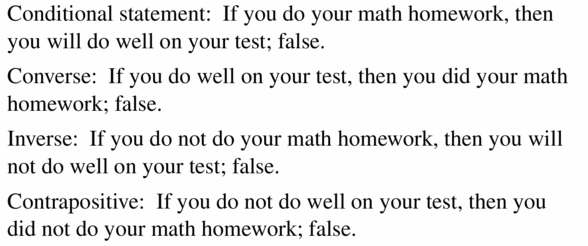
Question 20.
Let p be “you are not an only child” and let q be “you have a sibling.
Answer:
p → q
If you are not an only child, then you have a sibling.
Statement is true.
q → p
If you have a sibling, then you are not an only child.
Statement is true.
∼p → ∼q
If you are an only child, then you do not have a sibling.
Statement is true.
∼q → ∼p
If do not have a sibling, then you are an only child.
Statement is true.
Question 21.
Let p be “it does not snow” and let q be I will run outside.”
Answer:
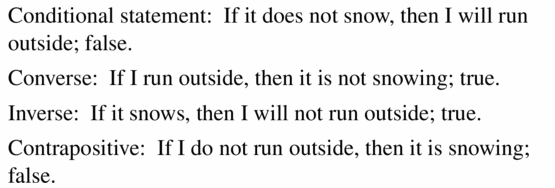
Question 22.
Let p be “the Sun is out” and let q be “it is day time”
Answer:
p → q
If the sun is out, then it is day time.
Statement is true.
q → p
If it is day time, then the sun is out.
Statement is true.
∼p → ∼q
If the sun is not out, then it is not day time.
Statement is true.
∼q → ∼p
If it is not day time, then the sun is not out.
Statement is true.
Question 23.
Let p be “3x – 7 = 20” and let q be “x = 9.”
Answer:

Question 24.
Let p be “it is Valentine’s Day” and let q be “it is February.
Answer:
p → q
If it is Valentine’s Day, then it is February.
q → p
If it is February, then it is Valentine’s Day.
∼p → ∼q
If it is not Valentine’s Day, then it is not February.
∼q → ∼p
If it is not February, then it is not Valentine’s Day.
In Exercises 25 – 28, decide whether the statement about the diagram is true. Explain your answer using the definitions you have learned.
Question 25.
m∠ABC = 90°
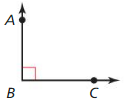
Answer:

Question 26.
![]()

Answer: If intersecting lines from a right angle, then they are perpendicular.
Question 27.
m∠2 + m∠3 = 180°

Answer:

Question 28.
M is the midpoint of \(\overline{A B}\).
![]()
Answer: It cannot be assumed that M is the midpoint unless \(\overline{A M}\) and \(\overline{B M}\) are marked as congruent.
In Exercises 29 – 32. rewrite the definition of the term as a biconditional statement.
Question 29.
The midpoint of a segment is the point that divides the segment into two congruent segments.
Answer:

Question 30.
Two angles are vertical angles when their sides form two pairs of opposite rays.
Answer: Two angles are vertical angles if and only if their sides form two pairs of opposite rays.
Question 31.
Adjacent angles are two angles that share a common vertex and side but have no common interior points.
Answer:

Question 32.
Two angles are supplementary angles when the sum of their measures 180°.
Answer: Two angles are supplementary angles if and only if the sum of their measures 180°.
In Exercises 33 – 36. rewrite the statements as a single biconditional statement.
Question 33.
If a polygon has three sides. then it is a triangle.
If a polygon is a triangle, then it has three sides.
Answer:
![]()
Question 34.
If a polygon has four sides, then it is a quadrilateral.
If a polygon is a quadrilateral, then it has four sides.
Answer: A polygon is a quadrilateral, if and only if it has four sides.
Question 35.
If an angle is a right angle. then it measures 90°.
If an angle measures 90°. then it is a right angle.
Answer:
![]()
Question 36.
If an angle is obtuse, then ii has a measure between 90° and 180°.
If an angle has a measure between 90° and 180°. then it is obtuse.
Answer: An angle is obtuse if and only if it has measure between 90° and 180°.
Question 37.
ERROR ANALYSIS
Describe and correct the error in rewriting the conditional statement in if – then form.

Answer:

Question 38.
ERROR ANALYSIS
Describe and correct the error in writing the converse of the conditional statement.

Answer:
Converse statement should just change a premise and conclusion. It should go like:
If I bring an umbrella, then it is raining.
In Exercises 39 – 44. create a truth table for the logical statement.
Question 39.
~ p → q
Answer:
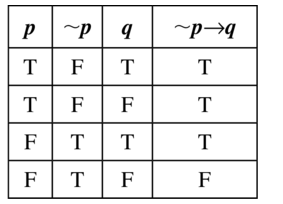
Question 40.
~ q → p
Answer:

Question 41.
~(~ p → ~ q)
Answer:
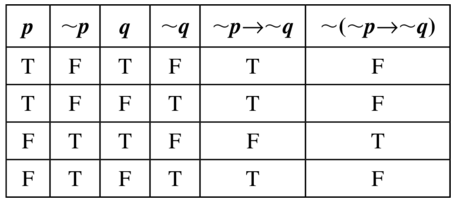
Question 42.
~ (p → ~ q)
Answer:
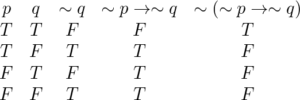
Question 43.
q → ~ p
Answer:
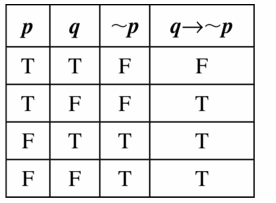
Question 44.
~ (q → p)
Answer:

Question 45.
USING STRUCTURE
The statements below describe three ways that rocks are formed.
Igneous rock is formed from the cooling of Molten rock.
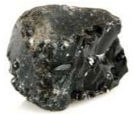
Sedimentary rock is formed from pieces of other rocks.
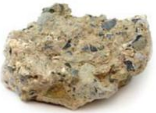
Metamorphic rock is formed by changing, temperature, pressure, or chemistry.
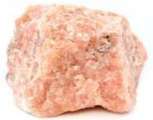
a. Write each sLaternenl in if-then form.
b. Write the converse of each of the statements in part (a). Is the converse of each statement true? Explain your reasoning.
c. Write a true if-then statement about rocks that is different from the ones in parts (a) and (b). Is the converse of our statement true or false? Explain your reasoning
Answer:
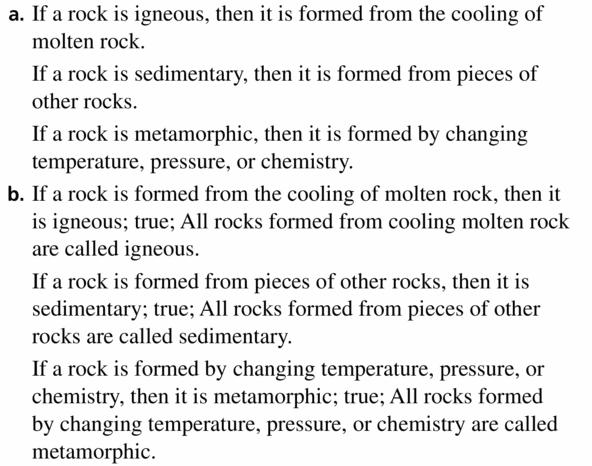
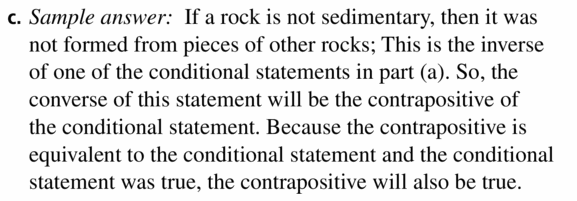
Question 46.
MAKING AN ARGUMENT
Your friend claims the statement “If I bought a shirt, then I went to the mall’ can he written as a true biconditional statement. Your sister says you cannot write it as a biconditional. Who is correct? Explain your reasoning.
Answer:
Converse of statement “If I bought a shirt, then I went to the mall” is If I went to the mall, then I bought a shirt.
As you can see, converse is false, so it cannot be written as biconditional statement, because both must be true or for that.
Your sister is correct.
Question 47.
REASONING
You are told that the contrapositive of a statement is true. Will that help you determine whether the statement can be written as a true biconditional statement’? Explain your reasoning.
Answer:

Question 48.
PROBLEM SOLVING
Use the conditional statement to identify the if-then statement as the converse. inverse. or contrapositive of the conditional statement. Then use the symbols to represent both statements.
Conditional statement: It I rode my bike to school, then I did not walk to school.
If-then statement: If did not ride my bike to school, then I walked to school.
p q ~ → ↔
Answer:
Both premise and conclusion are negated, so if then statement is invetse of conditional statement.
Premise: p = “I rode my bike to school”
Conclusion: q = “I walked to school”
Conditional: p → ~q
If-then statement:~p → q
USING STRUCTURE
In Exercises 49 – 52. rewrite the conditional statement in if-then form. Then underline the hypothesis and circle the conclusion.
Question 49.

Answer:

Question 50.

Answer: If you expect things from yourself, then you can do them.
Question 51.

Answer:

Question 52.

Answer: If someone is happy, then he will make others happy too.
Question 53.
MATHEMATICAL CONNECTIONS
Can the statement “If x2 – 10 = x + 2. then x = 4″ be combined with its converse to form a true biconditional statement?
Answer:

Question 54.
CRITICAL THINKING
The largest natural arch in the United States is Landscape Arch. located in Thompson, Utah. h spans 290 feet.

a. Use the information to write at least two true conditional statements.
Answer:
Two true conditional statements are:
1. If the largest natural arch is the Landscape Arch, then it spans 290 feet
2. If the largest natural arch is in the United States, then it is located in Thompson, Utah.
b. Which type of related conditional statement must also be true? Write the related conditional statements.
Answer:
One true related conditional statement is its contrapositive.
We can say the following based on the answers in a:
If a natural arch does not span 290 feet, then it is not the Landscape Arch.
C. What are the other two types of related conditional statements? Write the related conditional statements. Then determine their truth values. Explain your reasoning.
Answer:
Inverse and Converse: These statements are false because other natural archs in different countries can also span in 290 feet.
Question 55.
REASONING
Which statement has the same meaning as the given statement?
Given statement:
You can watch a movie after you do your homework.
(A) If you do your homework, then you can watch a movie afterward.
(B) If you do not do your homework, then you can watch a movie afterward.
(C) If you cannot watch a movie afterward. then do your homework.
(D) If you can watch a movie afterward, then do not do your homework.
Answer:

Question 56.
THOUGHT PROVOKING
Write three conditional statements. where one is always true, one is always false, and one depends on the person interpreting the statement.
Answer:
Always true: If the sun is up, then it is day.
Always false: If the sun is up, then it is night.
Depends: If the sun is up, then it is warm.
Question 57.
CRITICAL THINKING
One example of a conditional statement involving dates is “If today is August 31, then tomorrow is September 1 Write a conditional statement using dates from two different months so that the truth value depends on when the statement is read.
Answer:
![]()
Question 58.
HOW DO YOU SEE IT?
The Venn diagram represents all the musicians at a high school. Write three conditional statements in if-then form describing the relationships between the various groups of musicians.
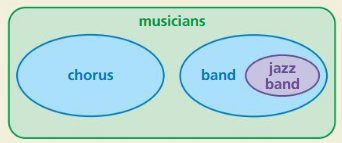
Answer:
If you are in the jazz band, then you are in the band.
If you are in the chorus you are not in the band.
If you are in the band or chorus you are a musician.
Question 59.
MULTIPLE REPRESENTATIONS
Create a Venn diagram representing each conditional statement. Write the converse of each conditional statement. Then determine whether each conditional statement and its converse are true or false. Explain your reasoning.
a. If you go to the zoo to see a lion, then you will see a Cat.
b. If you play a sport. then you wear a helmet.
c. If this month has 31 days. then it is not February.
Answer:
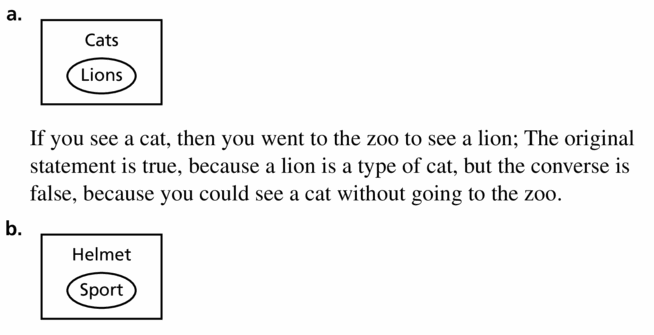

Question 60.
DRAWING CONCLUSIONS
You measure the heights of your classmates to gel a data set.
a. Tell whether this statement is true: If s and y are the least and greatest values in your data set, then the mean of the data is between x and y.
Answer: It is true
b. Write the converse of the statement in part (a). Is the converse true? Explain your reasoning.
Answer: If the mean of the data is between x and y, then x and y are the least and greatest values in your data set. No, because the x and y values are not always the least and the greatest numbers in the data set.
c. Copy and complete the statement below using mean, median, or mode to make a conditional statement that is true for an data set. Explain your reasoning.
If a data set has a mean. median, and a mode. then the _____________ of the data set will always be a data value.
Answer: If a data set has a mean. median, and a mode. then the mode of the data set will always be a data value.
Question 61.
WRITING
Write a conditional statement that is true, but its converse is false.
Answer:

Question 62.
CRITICAL THINKING
write a series of if-then statements that allow you to find the measure of each angle, given that m∠1 = 90° Use the definition of linear pairs.

Answer:
∠1 = 90° then ∠2 = 180° – 90° = 90° as they are supplementary angles and form a linear pair.
∠2 = 90° then ∠3 = 180° – 90° = 90° as they are supplementary angles and form a linear pair.
∠1 = 90° then ∠4 = 180° – 90° = 90° as they are supplementary angles and form a linear pair.
Question 63.
WRITING
Advertising slogans such as “Buy these shoes! They will make you a better athlete!” often imply conditional statements. Find an advertisement or write your own slogan. Then write it as a conditional statement.
Answer:

Maintaining Mathematical Proficiency
Find the pattern. Then draw the next two figures in the sequence.
Question 64.

Answer:
Sequence continues with pentagon and hexagon.
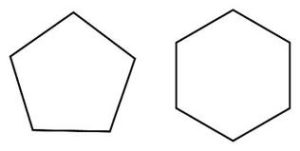
Question 65.

Answer:

Find the pattern. Then write the next two numbers.
Question 66.
1, 3, 5, 7 ……..
Answer:
This is a sequence of odd numbers
Next two numbers: 9, 11
Question 67.
12, 23, 34, 45 ……..
Answer:
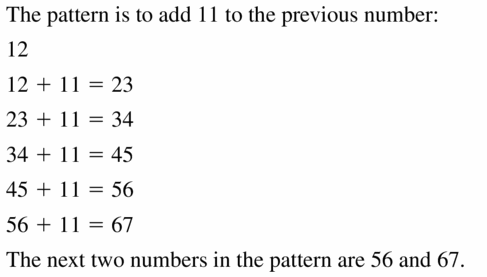
Question 68.
2, \(\frac{4}{3}, \frac{8}{9}, \frac{16}{27}\), ……..
Answer:
Each number gets multiplied with 2/3 to obtain next number.
Next two numbers: 32/81, 64/243
Question 69.
1, 4, 9, 16, ……..
Answer:

2.2 Inductive and Deductive Reasoning
Exploration 1
Writing a Conjecture
Work with a partner: Write a conjecture about the pattern. Then use your conjecture to draw the 10th object in the pattern.
a.

Answer: The circle is rotating from one vertex to the next in a clockwise direction
b.

Answer: The pattern alternates between a curve in an odd quadrant and a line with a negative slope in the even quadrant.
c.

Answer: The pattern alternates between the first three arrangements, then their respective mirror images.
Exploration 2
Using a Venn Diagram
Work with a partner: Use the Venn diagram to determine whether the statement is true or false. Justify your answer. Assume that no region of the Venn diagram is empty.
CONSTRUCTING VIABLE ARGUMENTS
To be proficient in math, you need to justify your conclusions and communicate them to others.

a. If an item has Property B. then it has Property A.
Answer: The given statement is true because property B is a part of property A.
b. If an item has Property A. then it has Property B.
Answer: The given statement is true because property B is a part of property A and not vice versa.
c. If an item has Property A, then it has Property C.
Answer: The given statement is true because property C is not completely part of property A.
d. Some items that have Property A do not have Property B.
Answer: The given statement is true because property B is a part of property A and not vice versa.
e. If an item has Property C. then it does not have Property B.
Answer: The given statement is true because property C is not a part of property B.
f. Sonic items have both Properties A and C.
Answer: The given statement is true because some part of property C is included in the part of property A.
g. Some items have both Properties B and C.
Answer: The given statement is false because property C is not a part of property B.
Exploration 3
Reasoning and Venn Diagrams
Work with a partner: Draw a Venn diagram that shows the relationship between different types of quadrilateral: squares. rectangles. parallelograms. trapezoids. rhombuses, and kites. Then write several conditional statements that are shown in your diagram. such as “If a quadrilateral is a square. then it is a rectangle.”
Answer:
Communicate Your Answer
Question 4.
How can you use reasoning to solve problems?
Answer:
Question 5.
Give an example of how you used reasoning to solve a real-life problem.
Answer:
Lesson 2.2 Inductive and Deductive Reasoning
Monitoring Progress
Question 1.
Sketch the fifth figure in the pattern in Example 1.
Answer:

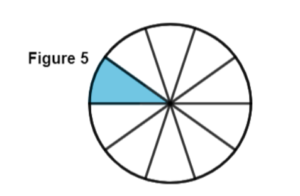
Question 2.

Answer:
The fifth figure in the pattern is shown below.
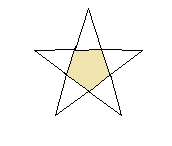
Question 3.

Answer:
Question 4.
Make and test a conjecture about the sign o1 the product of any three negative integers.
Answer: If you multiply two negative numbers, it will be equal to a positive number. If you multiply a positive number and a negative number, it will be equal to a negative number. So, multiplying three negative numbers is like multiplying a positive and negative number.
Example: (-1) × (-1) × (-1) = -1
Question 5.
Make and test a conjecture about the sum of any five consecutive integers.
Answer:
Statement: ‘The sum of any 5 consecutive integers.’
Let us consider 1, 2, 3, 4, 5
1 + 2 + 3 + 4 + 5 = 15
8 + 9 + 10 + 11 + 12 = 50
Hence the sum of any five consecutive integers is five times the third number
Find a counterexample to show that the conjecture is false.
Question 6.
The value of x2 is always greater than the value of x.
Answer: Yes, the statement is true.
Example: If x = 2
x² = 2² = 4
Question 7.
The sum of two numbers is always greater than their difference.
Answer: yes, the sum of two whole numbers is always greater than either number because even if one of the numbers to be added is 0, the answer will not be greater, but at least equal to it.
Question 8.
If 90° ∠ m ∠ R ∠ 180°, then ∠R is obtuse. The measure of ∠R is 155°. Using the Law of Detachment. what statement can you make?
Answer:
Given: The measure of ∠R=155
We know that an obtuse angle has a measurement greater than 90 degrees but less than 180 degrees.
Since ∠R=155 satisfies the hypothesis of a true conditional statement
Hence the conclusion is also true.
Hence the given angle R is obtuse.
Question 9.
Use the Law of Syllogism to write a new conditional statement that follows from the pair of true statements.
If you get an A on your math test. then you can go to the movies.
If you go to the movies, then you can watch your favorite actor.
Answer:
Question 10.
Use inductive reasoning to make a conjecture about the sum of a number and itself. Then use deductive reasoning to show that the conjecture is true.
Answer:
If the number is added to itself then the result is even.
n + n = 2n
Example:
0 + 0 = 0
2 + 2 = 4
The result is an even number.
Conjecture: If a number is added to itself then the result is always even.
Question 11.
Decide whether inductive reasoning or deductive reasoning is used to reach the
conclusion. Explain your reasoning.
All multiples of 8 are divisible by 4.
64 is a multiple of 8.
So, 64 is divisible by 4.
Answer:
Given: All multiples of 8 are divisible by 4.
64 is a multiple of 8.
So, 64 is divisible by 4.
All these are fact based, so it is deductive reasoning.
Exercise 2.2 Inductive and Deductive Reasoning
Vocabulary and Core Concept Check
Question 1.
VOCABULARY
How does the prefix “counter” help you understand the term counterexample?
Answer:

Question 2.
WRITING
Explain the difference between inductive reasoning and deductive reasoning.
Answer:
Inductive reasoning is finding a pattern in specific case and then writing a conjecture for the general case.
Deductive reasoning uses facts, definitions, accepted properties and the laws of logic to form a logical argument.
Inductive reasoning would be like generalizing and deductive reasoning would be like concluding.
Monitoring Progress and Modeling with Mathematics
In Exercises 3 – 8, describe the pattern. Then write or draw the next two numbers, letters, or figures.
Question 3.
1, – 2, 3, – 4, 5, ……..
Answer:

Question 4.
0, 2, 6, 12, 20, ……..
Answer:
This is sequence of numbers where first number is 0, and every next number is obtained by adding 2, 4, 6, … to previous number.
Next two numbers are: 30, 42
Question 5.
Z, Y, X, W, V, ……..
Answer:

Question 6.
J, F, M, A, M, ……..
Answer:
J = January, F = February, M = March, A = April, M = May
The next two letters would be J and J
J = June, J = July
Question 7.

Answer:

Question 8.

Answer: To identify the pattern and the next two numbers, letters or figures, use inductive reasoning.
The next two figures should contain 16 and 21 cubes.
In Exercises 9 – 12. make and test a conjecture about the given quantity.
Question 9.
the product of any two even integers
Answer:

Question 10.
the sum of an even integer and an odd integer
Answer:
4 + 3 = 7
10 + 15 = 25
The sum of an even integer and an odd integer is an odd integer.
Question 11.
the quotient of a number and its reciprocal
Answer:

Question 12.
the quotient of two negative integers
Answer:
-10/-2 = 5
-6/-3 = 2
The quotient of two negative integers is positive rational number.
In Exercises 13 – 16, find a counter example to show that the conjecture is false.
Question 13.
The product of two positive numbers is always greater than either number,
Answer:

Question 14.
If n is a nonzero integer, then \(\frac{n+1}{n}\) is always greater than 1.
Answer:
n = -1
-1+1/-1 = 0
Question 15.
If two angles are supplements of each other. then one of the angles must be acute.
Answer:
![]()
Question 16.
A line s divides \(\overline{M N}\) into two line segments. So, the lines is a segment bisector of \(\overline{M N}\)
Answer: A segment bisector by definition has to separate two lines into two equal pieces. In this case, we don’t know if the line s bisects MN into two equal parts.
In Exercises 17 – 20. use the Law of Detachment to determine what you can conclude from the given information, if possible.
Question 17.
If you pass the final, then you pass the class. You passed the final.
Answer:
![]()
Question 18.
If your parents let you borrow the ear, then you will go to the movies with your friend. you will go to the movies with your friend.
Answer: Conclusion of a true conditional statement is true, so we cannot conclude if the hypothesis is true or false.
Question 19.
If a quadrilateral is a square. then it has four right angles. Quadrilateral QRST has four right angles.
Answer:
![]()
Question 20.
If a point divides a line segment into two congruent line segments. then the point is a midpoint. Point P divides \(\overline{L H}\) into two congruent line segments.
Answer:
The law of Detachment can be used to deduce that since the hypothesis of true conditional statement is true, the conclusion is also true.
In Exercises 21 – 24, use the Law of Syllogism to write a new conditional statement that follows from the pair of true statements, if possible.
Question 21.
If x < – 2, then |x| > 2. If x > 2. then |x| > 2.
Answer:
![]()
Question 22.
If a = 3. then 5a = 15. If \(\frac{1}{2}\)a = 1\(\frac{1}{2}\), then a = 3.
Answer: If \(\frac{1}{2}\)a = 1\(\frac{1}{2}\) then 5a = 15
Question 23.
If a figure is a rhombus then the figure is a parallelogram. If a figure is a parallelogram, then the figure has two pairs of opposite sides that are parallel.
Answer:

Question 24.
If a figure is a square, then the figure has four congruent sides. If a figure is a square, then the figure has tour right angles.
Answer: The law of Syllogism cannot be used because the conclusion of neither conditional is the hypothesis of the other.
In Exercises 25 – 28. state the law of logic that is illustrated.
Question 25.
If you do your homework, then you can watch TV If you watch TV, then you can watch your favorite show.
If you do your homework. then you can watch your favorite show.
Answer:
![]()
Question 26.
If you miss practice the day before a game. then you will not be a starting player in the game.
You miss practice on Tuesday. You will not start the game Wednesday.
Answer: Deductive reasoning because Tuesday is before Wednesday, and you know that if you miss a practice the day before a game, you will not be a starting player, no matter what day the practice is.
Question 27.
If x > 12, then x + 9 > 20. The value of x is 14. So, x + 9 > 20.
Answer:
![]()
Question 28.
If ∠1 and ∠2 are vertical angles. then ∠1 ≅∠2.
If ∠1 ≅∠2 then m∠1 ≅ m∠2.
If ∠1 and ∠2 are vertical angles. then m∠1 = m∠2.
Answer: The law of Syllogism cannot be used because the conclusion of neither conditional is the hypothesis of the other.
In Exercises 29 and 30, use inductive reasoning to make a conjecture about the given quantity. Then use deductive reasoning to show that the conjecture is true.
Question 29.
the sum of two odd integers
Answer:
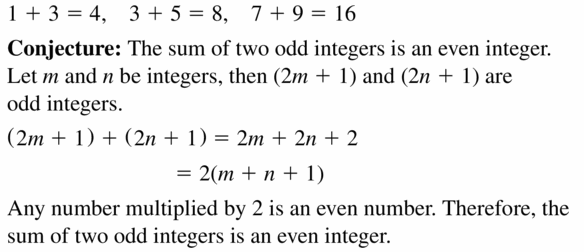
Question 30.
the product of two odd integers
Answer:
3 . 5 = 15
3 . 9 = 27
the product of two odd integers is odd integer.
In Exercises 31 – 34. decide whether inductive reasoning or deductive reasoning is used to reach the conclusion. Explain your reasoning.
Question 31.
Each time your mom goes to the store. she buy s milk. So. the next time your mom goes to the store. she will buy milk.
Answer:

Question 32.
Rational numbers can be written as fractions. Irrational numbers cannot be written as tractions. So. \(\frac{1}{2}\) is a rational number
Answer: Deductive reasoning because facts and laws of logic are used.
Question 33.
All men are mortal. Mozart is a man. so Mozart is mortal.
Answer:

Question 34.
Each time you clean your room. you are allowed to go out with your friends. So, the next time you clean your room. you will be allowed to go out with your friends.
Answer: Inductive reasoning because pattern is used.
ERROR ANALYSIS
In Exercises 35 and 36, describe and correct the error in interpreting the statement.
Question 35.
If a figure is a rectangle. then the figure has four sides.
A trapezoid has four sides.

Answer:

Question 36.
Each day, you get to school before your friend.

Answer: Using a pattern is inductive not deductive reasoning.
Question 37.
REASONING
The table Shows the average weights of several subspecies of tigers. What conjecture can you make about the relation between the weights of female tigers and the weights of male tigers? Explain our reasoning.
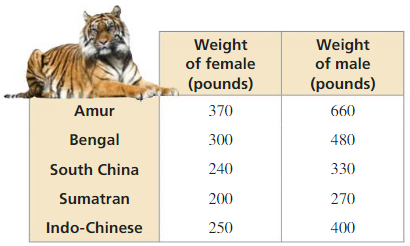
Answer:

Question 38.
HOW DO YOU SEE IT?
Determine whether you can make each conjecture from the graph. Explain your reasoning.

a. More girls will participate in high school lacrosse in Year 8 than those who participated in Year 7.
Answer: From graph you can see that the number of participants in high school lacrosse increases each year, so you can make that conjecture.
b. The number of girls participating in high school lacrosse will exceed the number of boys participating in high school lacrosse in Year 9.
Answer: You have no information about the number of boys participants in high school lacrosse.
Question 39.
MATHEMATICAL CONNECTIONS
Use inductive reasoning to write a formula for the sum of the first n positive even integers.
Answer:

Question 40.
FINDING A PATTERN
The following are the first nine Fibonacci numbers.
1, 1, 2, 3, 5, 8, 13, 21, 34, …….
a. Make a conjecture about each of the Fibonacci numbers after the first two.
Answer: Each number is the sum of two numbers before it
b. Write the next three numbers in the pattern.
Answer:
21 + 34 = 55
34 + 55 = 89
c. Research to find a real-world example of this pattern.
Answer:
Real life example Fibonacci numbers is number of pairs of rabbits after each generation.
Search for “Fibonacci’s Rabbits” on web.
Question 41.
MAKING AN ARGUMENT
Which argument is correct? Explain your reasoning.
Argument 1: If two angles measure 30° and 60° then the angles are complementary. ∠1 and ∠2 are complementary. So. m∠1 = 30° and m∠2 = 60°
Argument 2: If two angles measure 30° and 60°. then the angles are complementary. The measure of ∠1 is 30° and the measure of ∠2 is 60°. So, ∠1 and ∠2 are complementary.
Answer:

Question 42.
THOUGHT PROVOKING
The first two terms of a sequence are \(\frac{1}{4}\) and \(\frac{1}{2}\) Describe three different possible Patterns for the sequence. List the first five terms for each sequence.
Answer: Each term is multiplied with 2 to obtain next ter,
\(\frac{1}{4}\), \(\frac{1}{2}\), 1, 2, 4, 8, 16,….
Add \(\frac{1}{4}\) to each term to obtain next term
\(\frac{1}{4}\), \(\frac{1}{2}\), \(\frac{3}{4}\), 1, \(\frac{5}{4}\), \(\frac{3}{2}\), \(\frac{7}{4}\),….
terms \(\frac{1}{4}\) and \(\frac{1}{2}\) repeat
\(\frac{1}{4}\), \(\frac{1}{2}\), \(\frac{1}{4}\), \(\frac{1}{2}\),\(\frac{1}{4}\), \(\frac{1}{2}\),….
Question 43.
MATHEMATICAL CONNECTIONS
Use the table to make a conjecture about the relationship between x and y. Then write an equation for y in terms of x. Use the equation to test your conjecture for other values of x.

Answer:

Question 44.
REASONING
Use the pattern below. Each figure is made of squares that are 1 unit by 1 unit.

a. Find the perimeter of each figure. Describe the pattern of the perimeters.
Answer:
Perimeters:
4, 8, 12, 16, 20
Each figure has perimeter 4 times the order number of figure.
b. Predict the perimeter of the 20th figure.
Answer: 20th figure will have perimeter 80.
Question 45.
DRAWING CONCLUSIONS
Decide whether each conclusion is valid. Explain your reasoning.
- Yellowstone is a national park in Wyoming.
- You and your Friend went camping at Yellowstone National Park.
- When you go camping. you go canoeing.
- If you go on a hike, your Friend goes with you.
- You go on a hike.
- There is a 3-mile-long trail near your campsite.
a. You went camping in Wyoming.
b. Your Friend went canoeing.
c. Your friend went on a hike.
d. You and your Friend went on a hike on a 3-mile-long trail.
Answer:
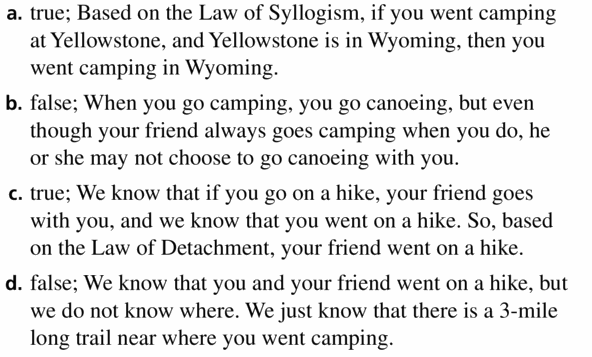
Question 46.
CRITICAL THINKING
Geologists use the Mohs’ scale to determine a mineral’s hardness. Using the scale. a mineral with a higher rating will leave a scratch on a mineral with a lower rating. Testing a mineral’s hardness can help identify the mineral.
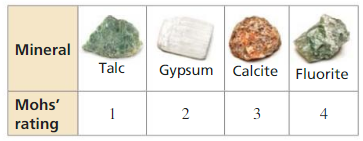
a. The four minerals are randomly labeled A, B, C, and D. Mineral A is scratched by Mineral B. Mineral C is scratched by all three of the other minerals. What can you conclude? Explain your reasoning.
Answer:
We start with the substance, mineral C, that is scratched by all.
This implies that it is the softest of all so C should be a task.
Mineral A is scratched by Mineral B implies that A is softer than B, so if A is Gypsum, the B can be Calcite or Fluorite. And if A is Calcite then B should be Fluorite.
b. What additional test(s) can you use to identify all the minerals in part (a)?
Answer: A test should be conducted between minerals B and D to differentiate between them, as in which one of these is Calcite and which one of them is Fluorite. According to the given data, this information is absent.
Maintaining Mathematical Proficiency
Determine which postulate is illustrated by the statement.
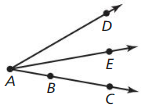
Question 47.
AB + BC = AC
Answer:
![]()
Question 48.
m∠DAC = m∠DAE + m∠EAB
Answer: Any angle measure is equal to the sum of its parts.
Question 49.
AD is the absolute value of the difference of the coordinates of A and D.
Answer:
![]()
Question 50.
m∠DAC is equal to the absolute value of the difference between the real numbers matched with \(\vec{A}\)D and \(\vec{A}\)C on a protractor.
Answer: Since the item is asking for the absolute value of the difference of the real numbers of the given rays on a protractor, it will yield the measure of m∠DAC.
This demonstrates the Protractor Postulate.
2.3 Postulates and Diagrams
Exploration 1
Looking at a Diagram
Work with a partner. On a piece of paper. draw two perpendicular lines. Label them ![]() and
and ![]() . Look at the diagram from different angles. Do the lines appear perpendicular regardless of the angle at which you look at them? Describe all the angles at which you can l00k at the lines and have them appear perpendicular.
. Look at the diagram from different angles. Do the lines appear perpendicular regardless of the angle at which you look at them? Describe all the angles at which you can l00k at the lines and have them appear perpendicular.
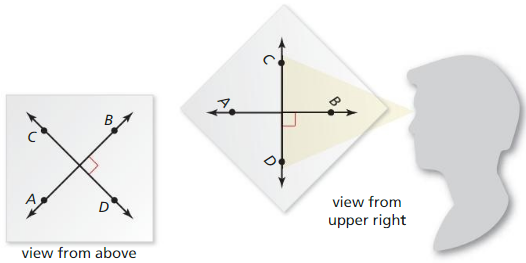
Answer:
Exploration 2
Interpreting a Diagram
Work with a partner: When you draw a diagram, you are communicating with others. It is important that you include sufficient information in the diagram. Use the diagram to determine which of the following statements you can assume to be true. Explain your reasoning.
ATTENDING TO PRECISION
To be proficient in math, you need to state the meanings of the symbols you choose.
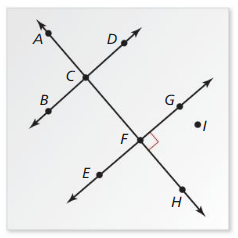


Answer:
Communicate Your Answer
Question 3.
In a diagram, what can be assumed and what needs to be labeled?
Answer:
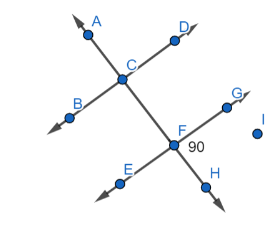
These statements that can be assumed are
- All the points shown are coplanar.
- Points A, C, H are collinear.
- EG and AH are perpendicular.
- ∠BCA and ∠ACD are linear pair.
- AF and BD are coplanar.
- AF and BD are intersect.
- ∠ACD and ∠BCF are vertical angles.
- EG and BD are parallel.
- AC and FH are the same line.
- If ∠ACD = ∠ACB = 90 degrees, then AF is perpendicular to BD.
Question 4.
Use the diagram in Exploration 2 to write two statements you can assume to be true and two statements you cannot assume to be true. Your statements should be different from those given in Exploration 2. Explain our reasoning.
Answer:
Lesson 2.3 Postulates and Diagrams
Monitoring progress
Question 1.
Use the diagram in Example 2. Which postulate allows you to say that the intersection of plane P and plane Q is a line?
Answer:
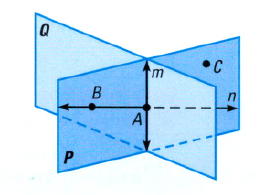
If two planes intersect, then their intersection is a line is satisfy the given intersection of plane P and plane Q is a line.
Question 2.
Use the diagram in Example 2 to write an example of the postulate.
a. Two Point Postulate
Answer: The two-point postulate states that when two points exist there exists a line that passes through the points. In plane P there lies points A and B through which a ‘n’ line this is known as the two point postulate.
b. Line-Point Postulate
Answer: The line-point postulate states that a line must have at least two points in it. Applying the postulate to the given figure it can be seen that the line has two points A and B.
c. Line Intersection Postulate
Answer: The line intersection postulate states that a line will intersect another line only at one point. Here it can be seen that line n intersects the line m at point A only which illustrates the line intersection postulate.
Refer back to Example 3.
Question 3.
If the given information states that \(\overline{P W}\) and \(\overline{Q W}\) arc congruent. how can you indicate that in the diagram?
Answer:
Question 4.
Name a pair of supplementary angles in the diagram. Explain.
Answer: There are actually four sets of supplementary angles in this diagram. You could choose any two angles that are next to each other as they would equal 180 degrees.
Use the diagram in Example 4.
Question 5.
Can you assume that plane S intersects plane T at ![]() ?
?
Answer:
Question 6.
Explain how you know ![]()
Answer:
Exercise 2.3 Postulates and Diagrams
Vocabulary and Core Concept Check
Question 1.
COMPLETE THE SENTENCE
Through any ___________ non collinear points. there exists exactly one plane.
Answer:

Question 2.
WRITING
Explain why you need at least three noncollinear points to determine a plane.
Answer: Two points determine a line, which could be on infinitely many planes, but only one plane will go through those two points and a third noncollinear point.
Monitoring Progress and Modeling with Mathematics
In Exercises 3 and 4. state the postulate illustrated by the diagram.
Question 3.

Answer:

Question 4.

Answer: This says that there are atleast 3 noncollinear points on a plane.
In Exercises 5 – 8, use the diagram to write an example of the postulate.

Question 5.
Line-Point Postulate (Postulate 2.2)
Answer:
![]()
Question 6.
Line Intersection Postulate (Postulate 2.3)
Answer: If two lines intersect, then their intersection is exactly one point.
The intersection of the line p and q is point H.
Question 7.
Three Point Postulate (Postulate 2.4)
Answer:

Question 8.
Plane-Line Postulate (Postulate 2.6)
Answer:
If two points lie in a plane, then the line containing them lies in the plane.
Points H and G lie in a plane M, so line p lies in plane M
In Exercises 9 – 12. sketch a diagram of the description.
Question 9.
plane P and line m intersection plane P at a 90° angle
Answer:

Question 10.
\(\overline{X Y}\) in plane P, \(\overline{X Y}\) bisected by point A. and point C not on \(\overline{X Y}\)
Answer:
Draw the necessary figures and label them properly. Make sure to put a red line across the bisected lines to indicate that they are congruent.

Question 11.
\(\overline{X Y}\) intersecting \(\overline{W V}\) at point A. so that XA = VA
Answer:
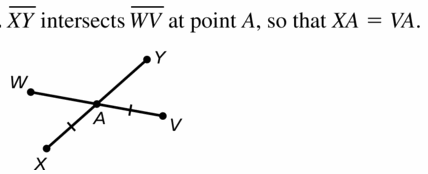
Question 12.
\(\overline{A B}\), \(\overline{C D}\), and \(\overline{E F}\) are all in plane P. and point x is the midpoint of all three segments.
Answer:
Draw the necessary figures and label them properly. Make sure to put a red line across the bisected lines to indicate that they are congruent.
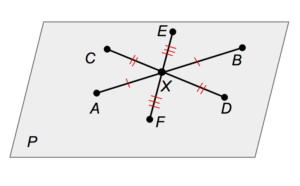
In Exercises 13 – 20, use the diagram to determine whether you can assume the statement.
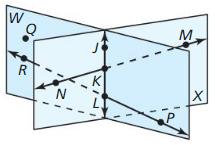
Question 13.
Planes Wand X intersect at ![]() .
.
Answer:
![]()
Question 14.
Points K, L, M, and N are coplanar.
Answer: Points K, L, M, and N are contained in plane X.
Question 15.
Points Q, J, and M are collinear.
Answer:

Question 16.
![]()
Answer: \(\overline{M N}\), \(\overline{R P}\) do not intersect.
Question 17.
![]() lies in plane X.
lies in plane X.
Answer:
![]()
Question 18.
∠PLK is a right angle.
Answer: ∠PLK is not marked as a right angle.
Question 19.
∠NKL and ∠JKM are vertical angles.
Answer:
![]()
Question 20.
∠NKI and ∠JKM are supplementary angles.
Answer:
∠NKJ and ∠JKM form a linear pair, so ∠NKI and ∠JKM are supplementary angles.
ERROR ANALYSIS
In Exercises 21 and 22. describe and correct the error in the statement made about the diagram.
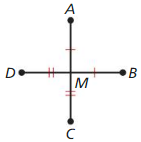
Question 21.

Answer:

Question 22.

Answer: There is no right angle, therefore the two intersecting segments are not perpendicular.
Question 23.
ATTENDING TO PRECISION
Select all the statements about the diagram that you cannot conclude.

(A) A, B, and C are coplanar.
(B) Plane T intersects plane S in ![]() .
.
(C) ![]() intersects
intersects ![]() .
.
(D) H, F, and D are coplanar.
(E) Plane T ⊥ plane S.
(F) Point B bisects \(\overline{H C}\).
(G) ∠ABH and ∠HBF are a linear pair.
(H) ![]()
Answer:
![]()
Question 24.
HOW DO YOU SEE IT?
Use the diagram of line m and point C. Make a conjecture about how many planes can be drawn so that line m and point C lie in the same plane. Use postulates too justify your conjecture.

Answer: Since line m already has two points based on the Line-Point Postulate, and these points are not collinear with point C, we can say that there is only one plane that goes through these three points based on the Three-Point Postulate.
Question 25.
MATHEMATICAL CONNECTIONS
One way to graph a linear equation is to plot two points whose coordinates satisfy the equation and then connect them with a line. Which postulate guarantees this process works for any linear equation?
Answer:
![]()
Question 26.
MATHEMATICAL CONNECTIONS
A way to solve a system of two linear equations that intersect is to graph the lines and find the coordinates of their intersection. Which postulate guarantees this process works for an two linear equations?
Answer: If two lines intersect, then their intersection is exactly one point.
In Exercises 27 and 28, (a) rewrite the postulate in if-then form. Then (b) write the converse, inverse, and contrapositive and state which ones are true.
Question 27.
Two Point Postulate (Postulate 2.1)
Answer:
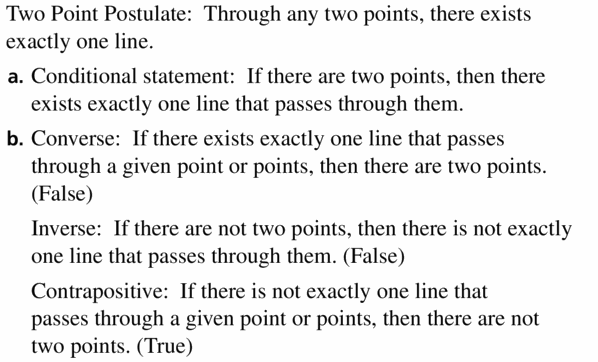
Question 28.
Plane-Point Postulate (Postulate 2.5)
Answer:
If there are more than three points then there is a plane.
Converse:
There is a plane if there are more than three points
Inverse: If there isn’t more than three points then there isn’t a plane.
Contrapositive: there isn’t a plane if there are not more than three points.
Question 29.
REASONING
Choose the correct symbol to go between the statements.
65
< ≤ = ≥ >
Answer:

Question 30.
CRITICAL THINKING
If two lines intersect, then they intersect in exactly one point by the Line Intersection Postulate (Postulate 2.3). Do the two lines have to be in the same plane ? Draw a picture to support your answer. Then explain your reasoning.
Answer: If two lines intersect then they intersect in exactly on one point by the line intersection postulate, but it is not necessary for them to lie on the same plane. Two lines can lie on 2 seperate planes and still intersect at a single point.
Question 31.
MAKING AN ARGUMENT
Your friend claims that even though two planes intersect in a line, it is possible for three planes to intersect in a point. Is your friend correct? Explain your reasoning.
Answer:

Question 32.
MAKING AN ARGUMENT
Your friend claims that by the Plane Intersection Postulate (Post. 2.7), any two planes intersect in a line. Is your friend’s interpretation 0f the Plane Intersection Postulate (Post. 2.7) correct? Explain your reasoning.
Answer: Your friend calims that by the plane intersection postulate, any two planes intersect in a line.
No. The postulate says that if two planes intersect, they will intersect in aline. But planes can be parallel and never intersect.
Question 33.
ABSTRACT REASONING
Points E, F, and G all lie in plane P and in plane Q. What must be true about points E, F. and G so that planes P and Q are different planes? What must be true about points E, F, and G to force planes P and Q to be the same plane? Make sketches to support your answers.
Answer:
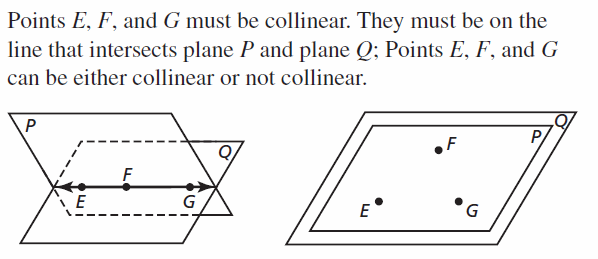
Question 34.
THOUGHT PROVOKING
The postulates in this book represent Euclidean geometry. In spherical geometry. all points are points on the surface of a sphere. A line is a circle on the sphere whose diameter is equal to the diameter of the sphere. A plane is the surface of the sphere. Find a postulate on page 84 that is not true in spherical geometry. Explain your reasoning.
Answer:
Since in Euclysian Geometry, the 3-point postulate states that for any three noncollinear points, there exists exactly one plane.
In spherical geometry, we can say that for three noncollinear points, they create three line segments. The endpoints of the line segments are the three noncollinear points.
Maintaining Mathematical Proficiency
Solve the equation. Tell which algebraic property of equality you used.
Question 35.
t – 6 = – 4
Answer:
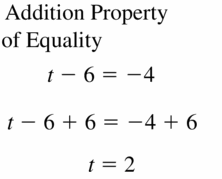
Question 36.
3x = 21
Answer:
Divison Property of Equality
3x = 21
x = 21/3
x = 7
Question 37.
9 + x = 13
Answer:

Question 38.
\(\frac{x}{7}\) = 5
Answer:
\(\frac{x}{7}\) = 5
x = 5 × 7
x = 35
Multiplication Property of Equality
2.1 – 2.3 Study Skills: Using the Features of Your Textbook to Prepare for Quizzes and Tests
Mathematical Practices
Question 1.
Provide a counter example for each false conditional statement in Exercises 17 – 24 on page 71.
(You do not need to consider the converse. inverse, and contrapositive statements.)
Answer:
17: Let p be “two angles are supplementary” and let q be “the measures of the sum of the angles to 180 degrees”.
Conditional: If two angles are supplementary then the measure of the sum of the angles is 180 degrees.
The statement is true.
18: Let p be “you are in math class” and let q be “you are in Geometry”.
Conditional: If you are in math class then you are in Geometry.
The statement is false.
19: Let p be “you do your math homework” and let q be “you will do well on the test”
Conditional: If you do your math homework then you will do well on the test.
The statement is false.
20: Let p be “you are not an only child” and let q be “you have a sibling.”
Conditional: If you are not an only child then you have a sibling.
The statement is true.
21: Let p be “it does not snow” and let q be “I will run outside”
Conditional: If it does not snow then I will run outside.
The statement is false.
22: Let p be the “sun is out” and let q be “its daytime”.
Conditional: If the sun is out then it is daytime.
The statement is true.
23: Let p be 3x – 7 = 20 and let q be x = 9.
Conditional: If 3x – 7 = 20 then x = 9.
The statement is true.
24: Let p be “it is Valentine’s Day” and let q be “it is February”
Conditional: If it is Valentine’s Day then it is February.
The statement is true.
Counterexamples are
18: Let p be “you are in math class” and let q be “you are in algebra”.
Geometry is a counterexample.
19: Let p be “you do your math homework” and let q be “you will do well on the English test”
Doing well on a math test is a counterexample.
21: Let p be “it does not rain” and let q be “I will run outside.”
If it does not snow, then it is a counterexample.
Question 2.
Create a truth table for each of your answers to Exercise 59 on page 74.
Answer:
Question 3.
For Exercise 32 on page 88. write a question you would ask your friend about his or her interpretation.
Answer:
2.1 – 2.3 Quiz
Rewrite the conditional statement in if-then form. Then write the converse, inverse, and contrapositive of the conditional statement. Decide whether each statement is true or false.
Question 1.
An angle measure of 167° is an obtuse angle.
Answer:
We are given the statement: An angle measure of 167° is an obtuse angle.
If then form: If angle measure of 167° then it is an obtuse angle. True
Converse: An angle is obtuse, its measure is 167°. False
Inverse: If angle measure is not167° then it is not an obtuse angle. False
Contrapositive: An angle is not obtuse, its measure is not 167°. False
Question 2.
You are in a physics class, so you always have homework.
Answer:
If then: If you are in a physics class, then you always have homework. True
Inverse: If you are not in a physics class, then you never have homework. False
Converse: If you always have homework, then you are in a physics class. False
Question 3.
I will take my driving test, So I will get my driver’s license.
Answer:
If then: If I will take my driving test, then I will get my driver’s license. True
Converse: If I will get my driver’s license, then I will take my driving test. False
Inverse: If I won’t take my driving test, then I won’t get my driver’s license. True
Find a countereample to show that the conjecture is false.
Question 4.
The sum of a positive number and a negative number is always positive.
Answer: Remember that a counterexample is to provide a number or reasoning to disprove the conjecture.
Question 5.
If a figure has four sides, then it is a rectangle.
Answer:
Remember that a counterexample is to provide a number or reasoning to disprove the conjecture.
A counterexample for the given conjecture is a square. A square also has 4 sides.
Use inductive reasoning to make a conjecture about the given quantity. Then use deductive reasoning to show that the conjecture is true.
Question 6.
the sum of two negative integers
Answer: According to inductive reasoning, the sum of two negative integers is always negative.
Question 7.
the difference of two even integers
Answer: According to inductive reasoning, the difference of two even integers is always an even integer.
Use the diagram to determine whether you can assume the statement.
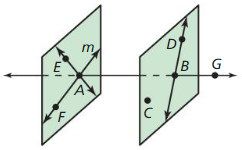
Question 8.
Points D, B, and C are coplanar.
Answer: They all appear to be on the same plane.
Question 9.
Plane EAF is parallel to plane DBC.
Answer: There is no proof to assume that they are parallel.
Question 10.
Line m intersects line ![]() at point it.
at point it.
Answer: It appears to intersect AB at point A.
Question 11.
Line ![]() lies in plane DBC.
lies in plane DBC.
Answer:
Question 12.
m∠DBG = 90°
Answer: We can’t assume this as we do not know the measures of these angles.
Question 13.
You and your friend are bowling. Your friend claims that the statement “If I got a strike, then I used thegreen ball” can be written as a true biconditional statement. Is your friend correct? Explain your reasoning. (Section 2.1)
Answer:
You do not have a green ball to get a strike.
Flip around the if-then statement.
If I used the green ball. then I got a strike.
Question 14.
The table shows the 1 – mile running times of the members of a high school track team.
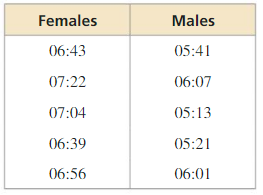
a. What conjecture can you make about the running times of females and males?
Answer: males were faster
b. What type of reasoning did you use? Explain.
Answer: Deductive reasoning because I used facts based on the chart.
Question 15.
List five of the seven Point, Line, and Plane Postulates on page 84 that the diagram of the house demonstrates. Explain how the postulate is demonstrated in the diagram.
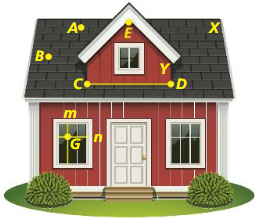
Answer:
The points A, B and X demonstrate 3 point postulate that a plane must contain three noncollinear points.
The plane containing the points A, B and X and the line CD demonstrate plane intersection postulate that when 2 planes intersect, then their intersection is a line.
The points m, n and G demonstrate three point postulate that a plane must contain three noncollinear points.
The point G demonstrate line intersection postulate that when 2 lines intersect then their point of intersection is 1 point. The end points of the lines here are m and n.
The points E and Y demonstrate plane line postulate that a plane containing these linear points must be a plane.
2.4 Algebraic Reasoning
Exploration 1
Justifying steps in a solution
Work with a partner: In previous courses. you studied diíIrcnt properties. such as the properties of equality and the Distributive, Commutative, and Associative Properties. Write the property that justifies each of the following solution steps.
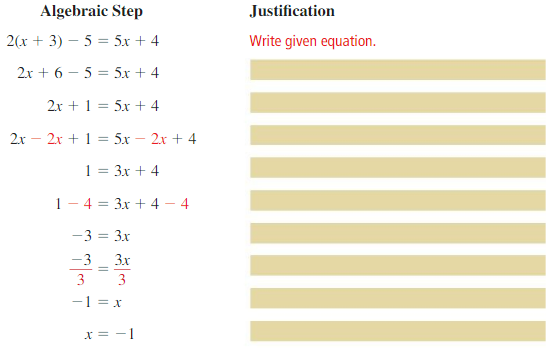
Answer:

Exploration 2
Stating Algebraic Properties
Work with a partner: The symbols ![]() and
and ![]() represent addition and multiplication (not necessarily in that order). Determine which symbol represents which operation. Justify your answer. Then state each algebraic property being illustrated.
represent addition and multiplication (not necessarily in that order). Determine which symbol represents which operation. Justify your answer. Then state each algebraic property being illustrated.
LOOKING FOR STRUCTURE
To be proficient in math, you need to look closely to discern a pattern or structure.
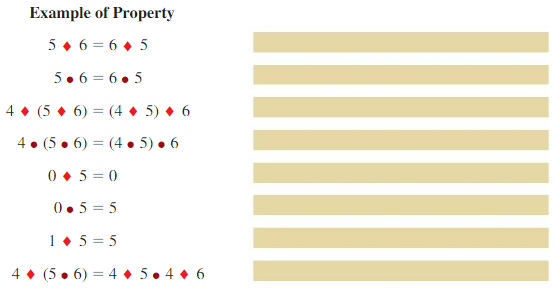
Answer:

Communicate Your Answer
Question 3.
How can algebraic properties help you solve an equation?
Answer:
Let us consider an Example to know how can algebraic properties help you solve an equation.
1/2 x + 4 = 12
1/2 x + 4 – 4 = 12 – 4
1/2x = 8
x = 8 × 2
x = 16
Question 4.
Solve 3(x + 1) – 1 = – 13. Justify each step.
Answer:
3(x + 1) – 1 = – 13
3x + 3 – 1 = -13
3x + 2 = -13
3x = -13-2
3x = -15
x = -5
Lesson 2.4 Algebraic Reasoning
Monitoring Progress
Solve the equation. Justify each step.
Question 1.
6x – 11 = – 35
Answer:
Given,
6x – 11 = – 35
6x = -35 + 11
6x = -24
x = -24/6
x = -4
Question 2.
– 2p – 9 = 10p – 17
Answer:
– 2p – 9 = 10p – 17
-2p – 10p = -17 + 9
-12p = -8
12p = 8
p = 8/12
p = 2/3
Question 3.
39 – 5z = -1 + 5z
Answer:
39 – 5z = -1 + 5z
-5z – 5z = -1 – 39
-10z = -40
10z = 40
z = 4
Question 4.
3(3x + 14) = – 3
Answer:
3(3x + 14) = – 3
9x + 42 = -3
9x = -3 – 42
9x = -45
x = -45/9
x = -5
Question 5.
4 = – 10b + 6(2 – b)
Answer:
4 = – 10b + 6(2 – b)
4 = -10b + 12 – 6b
4 = -16b + 12
-16b = 12 – 4
-16b = 8
b = -1/2
Question 6.
Solve the formula A = \(\frac{1}{2}\)bh for b. Justify each step. Then find the base of a
triangle whose area is 952 square feet and whose height is 56 feet.
Answer:
Given,
area is 952 square feet
height is 56 feet
A = \(\frac{1}{2}\)bh
952 = \(\frac{1}{2}\)b × 56
b = 34 feet
Name the property of equality that the statement illustrates.
Question 7.
If m∠6 = m∠7, then m∠7 = m∠6.
Answer: Symmetric property
Question 8.
34° = 34°
Answer: Reflexive property
Question 9.
m∠1 = m∠2 and m∠2 = m∠5. So, m∠1 = m∠5.
Answer: Transitive property
Question 10.
If JK = KL and KL = 16, then JK = 16.
Answer: Transitive property
Question 11.
PQ = ST, so ST = PQ.
Answer: Symmetric property
Question 12.
ZY = ZY
Answer: Reflexive property
Question 13.
In Example 5. a hot dog stand is located halfway between the shoe store and the pizza shop. at point H. Show that PH = HM.
Answer:
Exercise 2.4 Algebraic Reasoning
Vocabulary and Core Concept Check
Question 1.
VOCABULARY
The statement “The measure of an angle is equal to itself” is true because of what property?
Answer:
![]()
Question 2.
DIFFERENT WORDS, SAME QUESTION
Which is different? Find both answers.
What property justifies the following statement?
If c = d, then d = c.
If JK = LW. then LM = JK.
If e = f and f = g, then e = g.
If m∠R = m∠S, then m∠S = m∠R.
Answer:
The statement which is different here is If e = f and f = g, then e = g because this made use of Transitive Property of Equality and all other options made use of Reflexive Property of Equality.
Monitoring Progress and Modeling with Mathematics
In Exercises 3 and 4, write the property that justifies each step.
Question 3.
3x – 12 = 7x + 8 Given
– 4x – 12 = 8 ___________
– 4x = 20 ___________
x = – 5 ___________
Answer:

Question 4.
5(x – 1) = 4x + 13 Given
5x – 5 = 4x + 13 ___________
x – 5 = 13 ___________
x = 18 ___________
Answer:
Distributive Property of Multiplication over Subtraction
Subtraction Property of Equality
Addition Property of Equality
In Exercises 5 – 14. solve the equation. Justify each step.
Question 5.
5x – 10 = – 40
Answer:

Question 6.
6x + 17 = – 7
Answer:
Given,
6x + 17 = – 7
6x = -7 – 17
6x = -24
x = -24/6
x = -4
Question 7.
2x – 8 = 6x – 20
Answer:
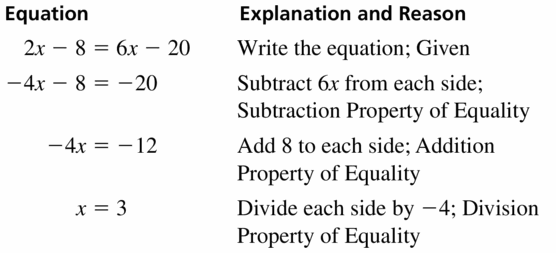
Question 8.
4x + 9 = 16 – 3x
Answer:
4x + 9 = 16 – 3x
4x + 3x = 16 – 9
7x = 7
x = 1
Question 9.
5(3x – 20) = – 10
Answer:
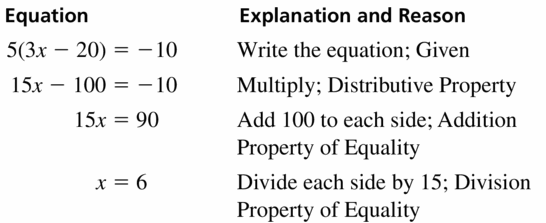
Question 10.
3(2x + 11) = 9
Answer:
3(2x + 11) = 9
6x + 33 = 9
6x = 9 – 33
6x = -24
x = -24/6
x = -4
Question 11.
2(- x – 5) = 12
Answer:
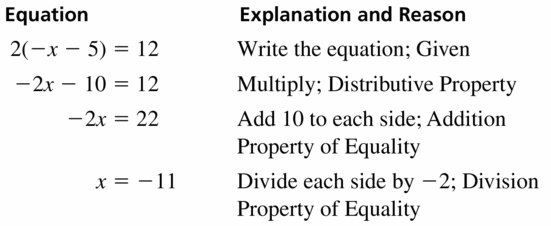
Question 12.
44 – 2(3x + 4) = – 18x
Answer:
44 – 2(3x + 4) = – 18x
44 – 6x – 8 = -18x
-6x + 18x = 8 – 44
12x = -36
x = -36/12
x = -3
Question 13.
4(5x – 9) = – 2(x + 7)
Answer:
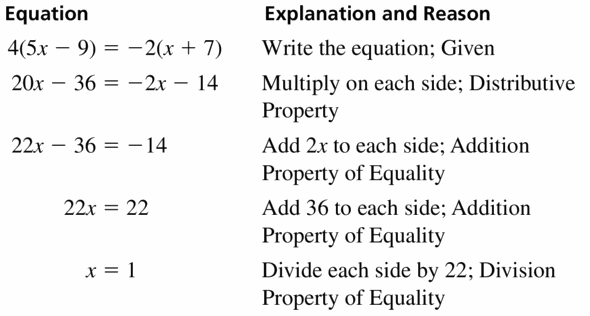
Question 14.
3(4x + 7) = 5(3x + 3)
Answer:
3(4x + 7) = 5(3x + 3)
12x + 21 = 15x + 15
12x – 15x = 15 – 21
-3x = -6
x = 2
In Exercises 15 – 20, solve the equation for y. Justify each step.
Question 15.
5x + y = 18
Answer:

Question 16.
– 4x + 2y = 8
Answer:
– 4x + 2y = 8
2y = 8 + 4x
y = 4 + 2x
Question 17.
2y – 0.5x = 16
Answer:

Question 18.
\(\frac{1}{2} x-\frac{3}{4} y\) = – 2
Answer:
\(\frac{1}{2} x-\frac{3}{4} y\) = – 2
2x – 3y = -8
-3y = -8 – 2x
3y = 8 + 2x
y = 8/3 + 2x/3
Question 19.
12 – 3y = 30x + 6
Answer:

Question 20.
3x + 7 = – 7 + 9y
Answer:
3x + 7 = – 7 + 9y
3x – 9y = -7 – 7
3x – 9y = -14
-9y = -14 – 3x
y = x/3 + 14/9
In Exercises 21 – 24. solve the equation for the given variable. Justify each step
Question 21.
C = 2πr; r
Answer:

Question 22.
I = Prt;P
Answer:
I = Prt
P = I/rt
Question 23.
S = 180(n – 2); n
Answer:

Question 24.
5 = 2πr2 + 2πrh; h
Answer:
S = 2πr2 + 2πrh
S – 2πr2 = 2πrh
h = S – 2πr2/2πr
In Exercises 25 – 32, name the property of equality that the statement illustrates.
Question 25.
If x = y, then 3x = 3y.
Answer:

Question 26.
If AM = MB. then AM + 5 = MB + 5.
Answer:
If a = b, the a + c = b + c
This is Addition Property of Equality
Question 27.
x = x
Answer:
![]()
Question 28.
If x = y, then y = x.
Answer: This is Symmetric Property of Equality used for Real Numbers.
Question 29.
m∠Z = m∠Z
Answer:
![]()
Question 30.
If m∠Z = 29° and m∠B = 29°, then m∠A = m∠B
Answer: For use Symmetric Property of Equality to show that 29° = m∠B, and then use Transitive Property of Equality.
Question 31.
If AB = LM, then LM = AB.
Answer:
![]()
Question 32.
If BC = XY and XY = 8, then BC = 8.
Answer: This is Transitive Property of Equality used for segment lengths.
In Exercises 33 – 40. use the property to copy and complete the statement.
Question 33.
Substitution Property of Equality:
If AB = 20. then AB + CD = ________ .
Answer:
![]()
Question 34.
Symmetric Property oÌ Equality:
If m∠1 = m∠2. then ________ .
Symmetric Property says that you can switch left and right side of equality.
If m∠1 = m∠2. then m∠2 = m∠1
Question 35.
Addition Property of Equality:
If AB = CD. then AB + EF = ________ .
Answer:
![]()
Question 36.
Multiplication Property of Equality:
If AB = CD, then 5 • AB = ________ .
Answer: Multiplication property says that you can multiply both sides of equality with same number.
If AB = CD, then 5 • AB = 5 . CD
Question 37.
Subtraction Property of Equality:
If LM = XY, then LM – GH = ________ .
Answer:
![]()
Question 38.
Distributive Property:
If 5(x + 8) = 2, then ___ + ___ = 2.
Answer:
If a(b + c) = d, then a . b + a . c = d
If 5(x + 8) = 2, then 5x + 40 = 2.
Question 39.
Transitive Property of Equality:
If m∠1 = m∠2 and m∠2 = m∠3, then ________ .
Answer:
![]()
Question 40.
Reflexive Properly of Equality:
m∠ABC = ________ .
Answer:
Reflexive property for angle measures says that each angle measure equals to itself.
m∠ABC = m∠ABC
ERROR ANALYSIS
In Exercises 41 and 42, describe and correct the error in solving the equation.
Question 41.

Answer:
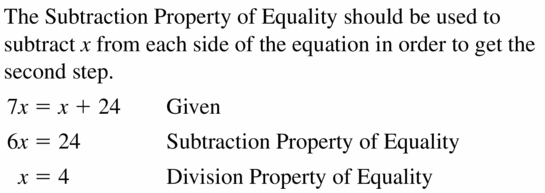
Question 42.
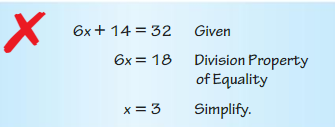
Answer:
6x + 14 = 32
6x = 32 – 14
6x = 18
x = 3
The second step should have stated that it made use of the subtraction property of equality since it has subtracted 14 from both sides of the equation.
Question 43.
REWRITING A FORMULA
The formula for the perimeter P of a rectangle is P = 2l + 2w, where l is the length and w is the width. Solve the formula for l. Justify each step. Then find the length of a rectangular lawn with a perimeter of 32 meters and a width of 5 meters.
Answer:

Question 44.
REWRITING A FORMULA
The formula for the area
A of a trapezoid is A = \(\frac{1}{2}\)h (b1 + b2), where h is the
height and b1 and b2 are the lengths of the two bases. Solve the formula for b1. Justify each step. Then find the length of one of the bases of the trapezoid when the area of the trapezoid is 91 square meters. the height is 7 meters. and the length of the other base is 20 meters.
Answer:
A = \(\frac{1}{2}\)h (b1 + b2)
2(A) = 2(\(\frac{1}{2}\)h (b1 + b2))
2A = h(b1 + b2)
b1 = 2A/h – b2
b1 = 2(91)/7 – 20
b1 = 26 – 20
b1 = 6 meters
Question 45.
ANALYZING RELATIONSHIPS
In the diagram,
m∠ABD = m∠CBE. Show that m∠1 = m∠3.
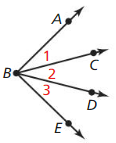
Answer:
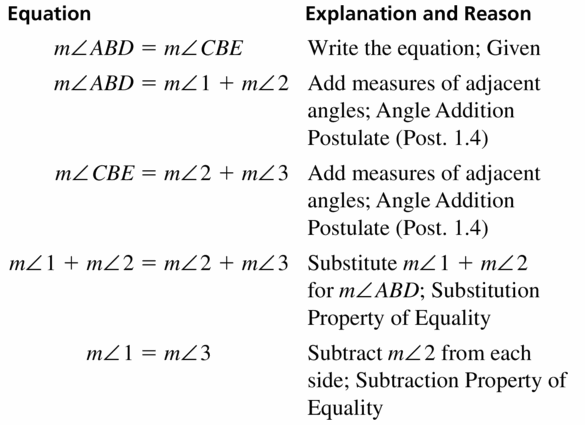
Question 46.
ANALYZING RELATIONSHIPS
In the diagram,
AC = BD. Show that AB = CD.
![]()
Answer:
AB = CD
Sum of 2 lengths
AB + BC = BC + CD
AB = CD
Hence proved that AB = CD.
Question 47.
ANALYZING RELATIONSHIPS
Copy and complete the table to show that m∠2 = m∠3.
| Equation | Reason |
| m∠1 = m∠4, m∠EFH = 90°, m∠GHF = 90° | Given |
| m∠EHF = m∠GHF | |
| m∠EHF = m∠1 + m∠2 m∠GHF = m∠3 + m∠4 |
|
| m∠1 + m∠2 = m∠3 + m∠4 | |
| Substitution Property of Equality | |
| m∠2 = m∠3 |
Answer:

Question 48.
WRITING
Compare the Reflexive Property of Equality with the Symmetric Property of Equality. How are the properties similar? How are they different?
Answer:
Both these properties are similar in the sense that they shoe relation between 2 quantities, the difference is that in the reflexive property the relation is with itself, while in Symmetric is with something else.
Example a = a is a reflexive property, but if a = b, then b = a based on symmetric property of equality.
REASONING
In Exercises 49 and 50. show that the perimeter of ∆ABC is equal to the perimeter of ∆ADC.
Question 49.

Answer:

Question 50.

Answer:
BC = DA, AB = CD
AC = AC
Ac + BC + AB = AC + BC + AB
AC + BC + AB = AC + DA + CD
Question 51.
MATHEMATICAL CONNECTIONS
In the figure, \(\overline{Z Y}\) ≅ \(\overline{X W}\), ZX = 5x + 17, YW = 10 – 2x, and YX = 3. Find ZY and XW

Answer:

Question 52.
HOW DO YOU SEE IT?
The bar graph shows the number of hours each employee works at a grocery store. Give an example of the Reflexive, Symmetric, and Transitive Properties of Equality.

Answer:
1. Employee 1 worked the same number of hours as employee 1.
2. If employee 4 worked the same number of hours as employee 5, then employee 5 worked the same number of hours as employee 4.
3. If employee 2 worked the same number of hours as employee 4 and employee 4 worked the same number of hours as employee 5, then employee 2 worked the same number of hours as employee 5.
Question 53.
ATTENDING TO PRECISION
Which of the following statements illustrate the Symmetric Property of Equality? Select all that apply.
(A) If AC = RS, then RS = AC.
(B) If x = 9 then 9 = x.
(C) If AD = BC, then DA = CB.
(D) AB = BA
(E) If AB = LW and LM = RT, then AB = RT.
(F) If XY = EF, then FE = XY.
Answer:
![]()
Question 54.
THOUGHT PROVOKING
Write examples from your everyday life lo help you remember the Reflexive, Symmetric, and Transitive Properties of Equality. Justify your answers.
Answer:
Reflexive Property: Pauline stayed in the bazaar same as the number of hours Pauline stayed.
Symmetric: If Pauline stayed in the bazaar same as the number of hours Nika stayed, then Nika stayed in the bazaar the same number of hours Pauline stayed.
Transitive Property: If Pauline stayed in the bazaar same as the number of hours Nika stayed, and Nika stayed in the bazaar the same number of hours Daniel did, then Pauline stayed in the bazaar the same number of hours Daniel did.
Question 55.
MULTIPLE REPRESENTATIONS
The formula to convert
a temperature in degrees Fahrenheit (°F) to degrees
Celsius (°C) is C = \(\frac{5}{9}\)(F – 32).
a. Solve the formula for F. Justify each step.
b. Make a table that shows the conversion to Fahrenheit for each temperature: 0°C. 20°C, 32°C. and 41°C.
c. Use your table to graph the temperature in degrees Fahrenheit as a function of the temperature in degrees Celsius. Is this a linear function?
Answer:
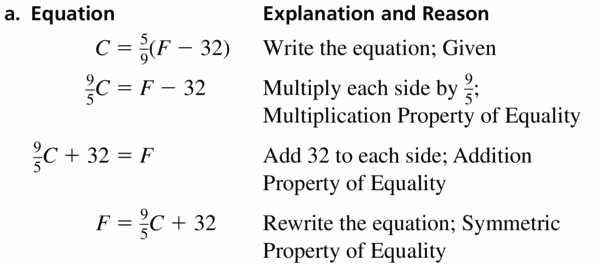
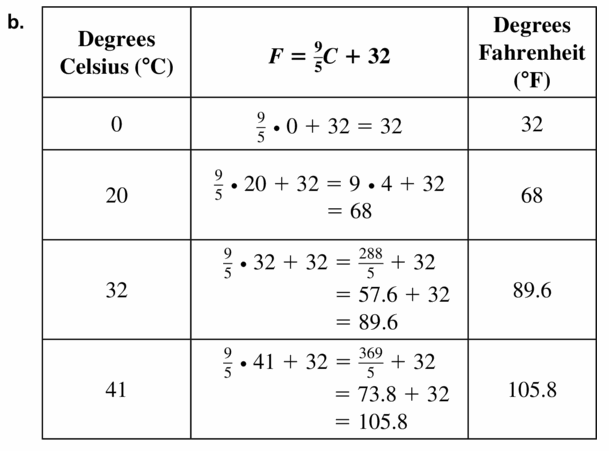
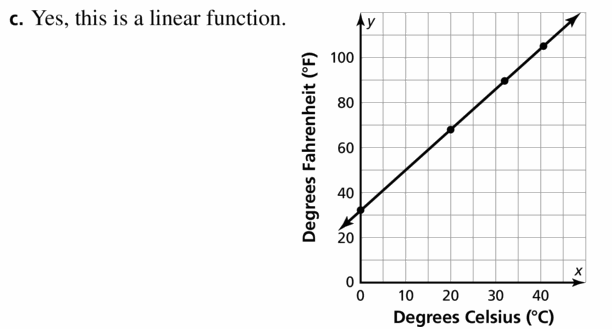
Question 56.
REASONING
Select all the properties that would also apply to inequalities. Explain your reasoning.
(A) Addition Property
Answer: Addition and subtraction properties can be applied since adding and subtracting values have the same effect on inequalities.
(B) Subtraction Properly
Answer: Addition and subtraction properties can be applied since adding and subtracting values have the same effect on inequalities.
(C) Substitution Property
Answer: Substitution Property cannot be applied since unequal sides cannot just have substituted values right away.
(D) Reflexive Property
Answer:
Reflexive Property cannot be applied since this property states that one value is equal to itself, and that does not hold true for inequalities.
(E) Symmetric Property
Answer:
Symmetric Property cannot be used unless the inequality symbols will be reversed when switching the values, as in If x > y, then y < x
(F) Transitive Property
Answer:
Transitive Property can be used as long as the inequality symbol used in the same for all statements.
Maintaining Mathematical Proficiency
Name the definition property, or postulate that is represented by each diagram.
Question 57.
![]()
XY + YZ = XZ
Answer:
![]()
Question 58.

Answer: An angle bisector cuts an angle into two congruent angles.
Question 59.
![]()
Answer:
![]()
Question 60.

m∠ABD + m∠DBC = m∠ABC
Answer: An angle measure is equal to the sum of its parts.
2.5 Proving Statements about Segments and Angles
Exploration 1
Writing Reasons in a proof
Work with a partner: Four steps of a proof are shown. Write the reasons for each statement
Given AC = AB + AB
Prove AB = BC
![]()
REASONING ABSTRACTLY
To be proficient in math, you need to know and be able to use algebraic properties.
| Statements | Reasons |
| 1. AC = AB + AB | 1. Given |
| 2. AB = BC = AC | 2. ______________________ |
| 3. AB + AB = AB + BC | 3. ______________________ |
| 4. AB = BC | 4. ______________________ |
Answer:
| Statements | Reasons |
| 1. AC = AB + AB | 1. Given |
| 2. AB = BC = AC | 2. Symmetric Property |
| 3. AB + AB = AB + BC | 3. Substitution Property of Equality |
| 4. AB = BC | 4. Reflexive Property |
Exploration 2
Writing Steps in a Proof
Work with a partner: Six steps of a proof are shown. Complete the statements that correspond to each reason.
Given m∠1 = m∠3
Prove m∠EBA = m∠CBD
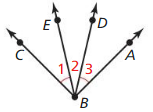
| Statements | Reasons |
| 1. ___________________________ | 1. Given |
| 2. m∠EBA = m∠2 + m∠3 | 2. Angle Addition Postulate (Post.1.4) |
| 3. m∠EBA = m∠2 + m∠1 | 3. Substitution Property of Equality |
| 4. m∠EBA = ___________________________ | 4. Commutative Property of Addition |
| 5. m∠1 + m∠2 = ______________________ | 5. Angle Addition Postulate (Post. 1.4) |
| 6. ________________________________________ | 6. Transitive Property of Equality |
Answer:
| Statements | Reasons |
| 1. m∠1 = m∠3 | 1. Given |
| 2. m∠EBA = m∠2 + m∠3 | 2. Angle Addition Postulate (Post.1.4) |
| 3. m∠EBA = m∠2 + m∠1 | 3. Substitution Property of Equality |
| 4. m∠EBA = m∠1 + m∠2 | 4. Commutative Property of Addition |
| 5. m∠1 + m∠2 = m∠CBD | 5. Angle Addition Postulate (Post. 1.4) |
| 6. m∠EBA = m∠CBD | 6. Transitive Property of Equality |
Communicate Your Answer
Question 3.
How can you prove a mathematical statement?
Answer:
There are three ways to prove a statement of the form “If A, then B.” They are called direct proof, contra- positive proof, and proof by contradiction. DIRECT PROOF. To prove that the statement “If A, then B” is true by means of direct proof, begin by assuming A is true and use this information to deduce that B is true.
Question 4.
Use the given information and the figure to write a proof for the statement.
Given B is the midpoint of \(\overline{A C}\).
C is the midpoint of \(\overline{B D}\).
Prove AB = CD
![]()
Answer:
Lesson 2.5 Proving Statements about Segments and Angles
Monitoring Progress
Question 1.
Six Steps of a two-column proof are shown. Copy and complete the proof.
![]()
Given T is the midpoint of \(\overline{S U}\).
Prove x = 5
| Statement | Reason |
| 1. T is the midpoint of \(\overline{S U}\). | 1. ________________________________________ |
| 2. \( \overline{S T} \cong \overline{T U} \) | 2. Definition of midpoint |
| 3. ST = TU | 3. Definition of congruent segments |
| 4. 7x = 3x + 20 | 4. ________________________________________ |
| 5. ________________________________________ | 5. Subtraction Property of Equality |
| 6. x = 5 | 6. ________________________________________ |
Answer:
| Statement | Reason |
| 1. T is the midpoint of \(\overline{S U}\). | 1. Given |
| 2. \( \overline{S T} \cong \overline{T U} \) | 2. Definition of midpoint |
| 3. ST = TU | 3. Definition of congruent segments |
| 4. 7x = 3x + 20 | 4. By the substitution property |
| 5. 7x – 3x = 3x + 20 – 3x 4x = 20 |
5. Subtraction Property of Equality |
| 6. x = 5 | 6. Division property of equality |
Exercise 2.5 Proving Statements about Segments and Angles
Vocabulary and Core Concept Check
Question 1.
WRITING
How is a theorem different from a postulate?
Answer:

Question 2.
COMPLETE THE SENTENCE
In a two-column proof, each __________ is on the left and each __________ is on the right.
Answer: In a two-column proof, each statement is on the left and each reason is on the right.
Monitoring Progress and Modeling with Mathematics
In Exercises 3 and 4. copy and complete the proof.
Question 3.
Given PQ = RS
Prove PR = QS
![]()
| Statements | Reasons |
| 1. PQ = RS | 1. ________________________________________ |
| 2. PQ + QR = RS + QR | 2. ________________________________________ |
| 3. ________________________________________ | 3. Segment Addition Postulate (Post. 1.2) |
| 4. RS + QR = QS | 4. Segment Addition Postulate (Post. 1.2) |
| 5. PR = QS | 5. ________________________________________ |
Answer:

Question 4.
Given ∠1 is a complement of ∠2.
∠2 ≅ ∠3
Prove ∠1 is a complement of ∠3.

| Statements | Reasons |
| 1. ∠1 is a complement of ∠2. | 1. Given |
| 2. ∠2 ≅ ∠3 | 2. _____________________________ |
| 3. m∠1 + m∠2 = 90° | 3. _____________________________ |
| 4. m∠2 = m∠3 | 4. Definition of congruent angles |
| 5. _____________________________ | 5. Substitution Property Of Equality |
| 6. ∠1 is a complement of ∠3. | 6. _____________________________ |
| Statements | Reasons |
| 1. ∠1 is a complement of ∠2. | 1. Given |
| 2. ∠2 ≅ ∠3 | 2. Given |
| 3. m∠1 + m∠2 = 90° | 3. Definition of complementary angles |
| 4. m∠2 = m∠3 | 4. Definition of congruent angles |
| 5. m∠1 + m∠3 = 90° | 5. Substitution Property Of Equality |
| 6. ∠1 is a complement of ∠3. | 6. Definition of complementary angles is that their measure add up to 90. |
In Exercises 5-10, name the property that the statement illustrates.
Question 5.
If \(\overline{P Q} \cong \overline{S T}\) and \(\overline{S T} \cong \overline{U V}\), then \(\overline{P Q} \cong \overline{U V}\).\
Answer:
![]()
Question 6.
∠F ≅ ∠F
Answer: Reflexive Property of Angle Congruence
Question 7.
If ∠G ≅∠H. then ∠H ≅ ∠G.
Answer:
![]()
Question 8.
\(\overline{D E} \cong \overline{D E}\)
Answer: The statement is talking about reflexity involving line segments, we can say that this observes the Reflexive Property of Segment Congruence
Question 9.
If \(\overline{X Y} \cong \overline{U V}\), then \(\overline{U V} \cong \overline{X Y}\).
Answer:
![]()
Question 10.
If ∠L ≅∠M and ∠M ≅∠N, then ∠L ≅∠N.
Answer: Since the if-then statement is talking about transitivity involving angles, we can say that this observes the Transitive Property of Angle Congruence
PROOF
In Exercises 11 and 12, write a two-column proof for the property.
Question 11.
Reflexive Property of Segment Congruence (Thm. 2.1)
Answer:
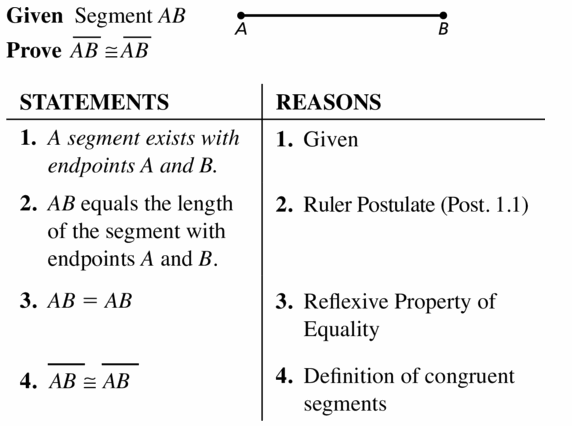
Question 12.
Transitive Property of Angle Congruence (Thm. 2.2)
Answer:
∠1 ≅∠2
∠2 ≅∠3
m∠1 = m∠2
m∠2 = m∠3
Transitive property of equality
m∠1 = m∠3
Congruent angles
∠1 ≅∠3
PROOF
Exercises 13 and 14. write a two-column proof.
Question 13.
Given ∠GFH ≅ ∠GHF
Prove ∠EFG and ∠GHF are supplementary

Answer:
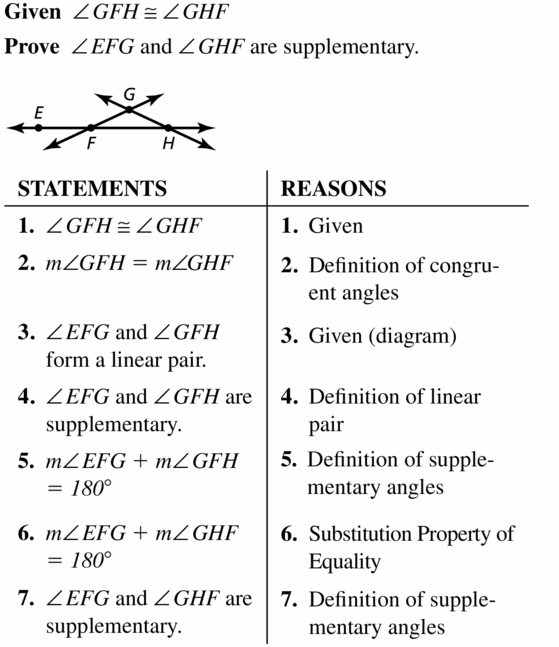
Question 14.


Answer:

AB = FG
\(\overline{A B}\) ≅ \(\overline{F G}\)
\(\overline{D F}\) ≅ \(\overline{F G}\)
Congruent segments
AB = BC
DF = FG
From AB = BC and AB = FG – substitution property of equality
BC = FG
From BC = FG and DF = FG – substitution property of equality
\(\overline{B C}\) ≅ \(\overline{D F}\)
Question 15.
ERROR ANALYSIS
In the diagram \(\overline{M N} \cong \overline{L Q}\) and \(\overrightarrow{L Q} \cong \overrightarrow{P N}\). Describe and correct the error in the reasoning.
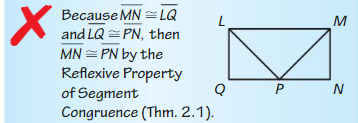
Answer:

Question 16.
MODELING WITH MATHEMATICS
The distance fr the restaurant to the shoe store is the same as the distance from the cafe to the florist. The distance from the shoe store to the movie theater is the same as the distance from the movie theater to the cafe, and from the florist to the dry cleaners.

Use the steps below to prove that the distance from the restaurant to the movie theater is the same as the distance from the cafe to the dry cleaners.
Answer:
Name each point:
R – restaurant
S – shoe store
M – movie theater
C – cafe
F – florist
D – dry cleaners
RS = CF
SM = MC = FD
RM = CD
b. Write a two-column proof.
Answer:
RM = RS + SM
CD = CF + FD
RM = CF + SM
CD = CF + MC
RM = CD
Question 17.
REASONING
In the sculpture shown, \(\angle 1 \cong \angle 2\) and \(\angle 2 \cong \angle 3\) classify the triangle and justify your answer.
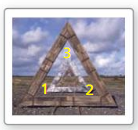
Answer:

Question 18.
MAKING AN ARGUMENT
In the figure, \(\overline{S R} \cong \overline{C B}\) and \(\overline{A C} \cong \overline{Q R}\) Your friend claims that, because of this. \( \overline{C B} \cong \overline{A C}\) by the Transitive Property of Segment Congruence (Thin. 2. 1). Is your friend correct? Explain your reasoning.

Answer:
Your friend is not correct, because there is no basis for using Transitive property.
It should be given \(\overline{S B} \cong \overline{C B}\) and \(\overline{S R} \cong \overline{A C}\)
So we conclude that \( \overline{C B} \cong \overline{A C}\) by the transitive property of segment congruence.
Question 19.
WRITING
Explain why you do not use inductive reasoning when writing a proof.
Answer:
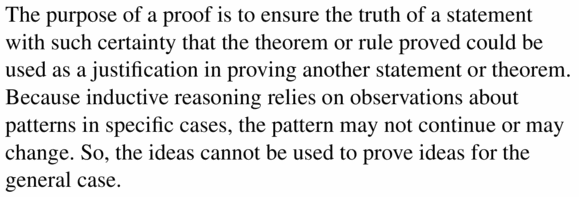
Question 20.
HOW DO YOU SEE IT?
Use the figure to write Given and Prove statements for each conclusion.

a. The acute angles of a right triangle are complementary.
Answer:
The given statement here is that ΔJML is a right triangle.
Prove that the acute angles of a right triangle are complementary.
b. A segment connecting the midpoints of two sides of a triangle is half as long as the third side.
Answer:
The given statement here is that ΔJML is a right triangle, K is the midpoint of \(\overline{J L}\) and N is the midpoint of \(\overline{J M}\) because the midpoints bisects the segment into two congruent parts
Question 21.
REASONING
Fold two corners of a piece of paper So their edges match. as shown.
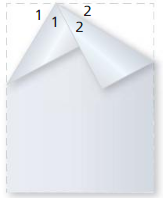
a. What do you notice about the angle formed at the top of the page by the folds?
b. Write a two-column proof to show that the angle measure is always the same no matter how you make the folds.
Answer:
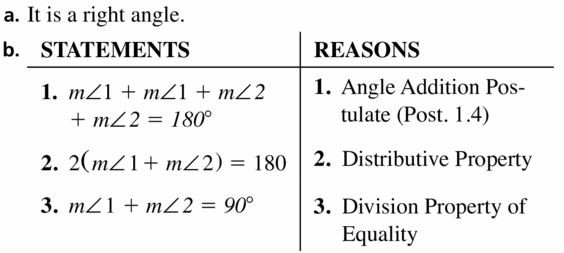
Question 22.
THOUGHT PROVOKING
The distance from Springfield
to Lakewood City is equal to the distance from Springfield Lo BettsilIe. Janisburg is 50 miles farther from Springfield titan Bettsville. Moon Valley is 50 miles Farther from Springfield than Lakewood City is. Use line segments to draw a diagram that represents this situation.
Answer:

Question 23.
MATHEMATICAL CONNECTIONS
Solve for x using the given information. Justify each step.
Given \(\overline{Q R} \cong \overline{P Q}, \overline{R S} \cong \overline{P Q}\)

Answer:
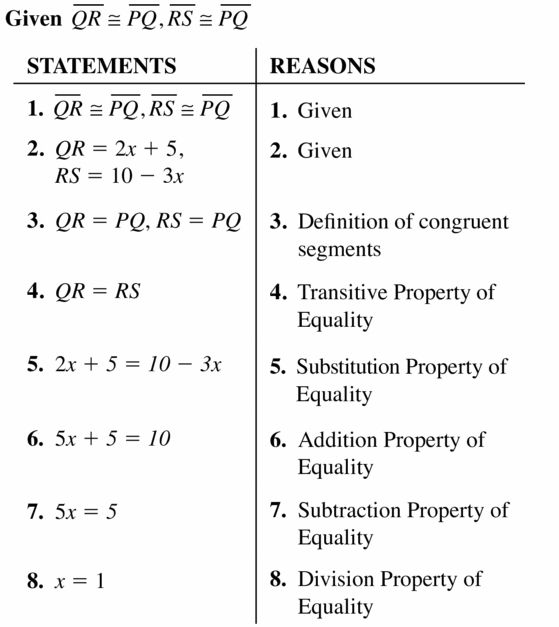
Maintaining Mathematical Proficiency
Use the figure
Question 24.
∠ 1 is a complement of ∠4. and m∠1 33°. Find in m∠4.
Answer:
m∠1 + m∠4 = 90°
33° + m∠4 = 90°
m∠4 = 90° – 33°
m∠4 = 57°
Question 25.
∠3 is a supplement of ∠2, and m∠2 = 147°. Find m∠3.
Answer:
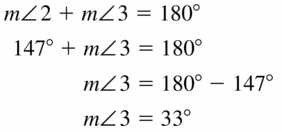
Question 26.
Name a pair of vertical angles.

Answer: ∠1 and ∠3
2.6 Proving Geometric Relationships
Exploration 1
Matching Reasons in a Flowchart Proof
work with a partner: Match each reason with the correct step in the flowchart.
![]()
Given AC = AB + AB
Prove AB = BC

MODELING WITH MATHEMATICS
To be proficient in math, you need to map relationships using such tools as diagrams, two-way tables, graphs, flowcharts, and formulas.
A. Segment Addition Postulate (Post. 1.2)
Answer:
B. Given
Answer:
C. Transitive Property of Equality
Answer:
D. Subtraction Property of Equality
Answer:
Exploration 2
Matching Reasons in a Flowchart Proof
Work with a partner. Match each reason with the Correct step in the flowchart.
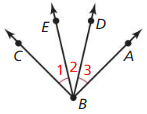
Given m∠1 = m∠3
Prove m∠EBA = m∠CBD
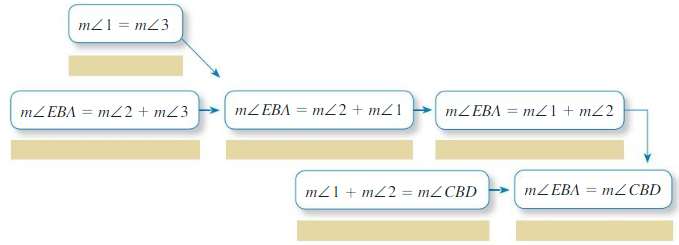
A. Angle Addition Postulate (Post. 1.4)
Answer: m∠EBA = m∠2 + m∠3
B. Transitive Property of Equality
Answer: m∠EBA = m∠CBD
C. Substitution Property of Equality
Answer: m∠EBA = m∠2 + m∠1
D. Angle Addition Postulate (Post. 1.4)
Answer: m∠1 + m∠2 = m∠CBD
E. Given
Answer: m∠1 = m∠3
F. Commutative Property of Addition
Answer: m∠EBA = m∠1 + m∠2
Communicate Your Answer
Question 3.
How can you use a flowchart to prove a mathematical statement?
Answer: Flowchart proof is a concept map showing the statement and reason required for proof in a logical order.
Question 4.
Compare the flowchart proofs above with the two-column proofs in the Section 2.5 Explorations. Explain the advantages and disadvantages of each.
Answer:
Advantages
Two-column proofs are a more organized and less time-consuming way to write proofs especially if they are long.
Disadvantages
These are somewhat boring to look at and generally require more attention from the reader to understand.
Compared to a flowchart, it requires the reader to connect two or more ideas that lead to another statement.
| Statement | Reason |
| m∠2 = m∠3 | Given |
| m∠1 + m∠2 = 90 | Reason |
| m∠1 + m∠3 = 90 | Substitution property of equality |
Lessson 2.6 Proving Geometric Relationships
Monitoring Progress
Question 1.
Copy and complete the flowchart proof. Then write a two-column proof.

Given \(\overline{A B}\) ⊥ \(\overline{B C}\), \(\overline{D C}\) ⊥ \(\overline{B C}\)
Prove ∠B ≅∠C

Answer:
| Statement | Reason |
| Given \(\overline{A B}\) ⊥ \(\overline{B C}\), \(\overline{D C}\) ⊥ \(\overline{B C}\) | Given |
| ∠B and ∠C are right angles | Definition of ⊥ lines |
| ∠B ≅∠C | Right angles Congruence Theorem |
Question 2.
Copy and complete the two-column proof. Then write a flowchart proof.
![]()
Given AB = DE, BC = CD
Prove \(\overline{A C} \cong \overline{C E}\)
| Statements | Reasons |
| 1. AB = DE, BC = CD | 1. Given |
| 2. AB + BC = BC + DE | 2. Addition Property of Equality |
| 3. _____________________________ | 3. Substitution Property of Equality |
| 4. AB + BC = AC, CD + DE = CE | 4. _____________________________ |
| 5. _____________________________ | 5. Substitution Property of Equality |
| 6. \( \overline{A C} \cong \overline{C E} \) | 6. _____________________________ |
Answer:
| Statements | Reasons |
| 1. AB = DE, BC = CD | 1. Given |
| 2. AB + BC = BC + DE | 2. Addition Property of Equality |
| 3. AB + BC = BC + AB, DE + CD = CD + DE | 3. Substitution Property of Equality |
| 4. AB + BC = AC, CD + DE = CE | 4. Segment Addition Postulate |
| 5. AB + BC = AC, BC + AB = CE | 5. Substitution Property of Equality |
| 6. \( \overline{A C} \cong \overline{C E} \) | 6. Transitive Property of Equality |
Question 3.
Rewrite the two-column proof in Example 3 without using the Congruent Supplements Theorem. How many steps do you save by using the theorem?
Answer:
Given ∠5 and ∠7 are vertical angles
∠5 ≅∠7 (Vertical angles Congruence Theorem)
Use the diagram and the given angle measure to find the other three angle measures.

Question 4.
m∠1 = 117°
Answer:
m∠1 = 117°
m∠3 = 117° (vertical angles)
m∠2 = 63°
m∠4 = 63° (vertical angles)
Question 5.
m∠2 = 59°
Answer:
m∠2 = 59°
m∠4 = 59° (vertical angles)
180 – 59 = 121
m∠1 = 121°
m∠3 = 121° (vertical angles)
Question 6.
m∠4 = 88°
Answer:
m∠4 = 88°
m∠2 = 88° (vertical angles)
180 – 88 = 92
m∠1 = 92°
m∠3 = 92° (vertical angles)
Question 7.
Find the value of w.
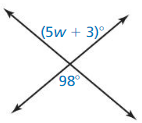
Answer:
5w + 3 + 98 = 180
5w + 101 = 180
5w = 180 – 101
5w = 79
w = 15.8°
Question 8.
write a paragraph proof.

Given ∠1 is a right angle.
Prove ∠2 is a right angle.
Answer:
Given ∠1 is a right angle.
∠1 = 90
∠1 + ∠2 = 180
∠2 + 90 = 180
∠2 = 180 – 90
∠2 = 90
Hence ∠2 is a right angle.
Exercise 2.6 Proving Geometric Relationships
Vocabulary and Core Concept Check
Question 1.
WRITING
Explain why all right angles are congruent.
Answer:

Question 2.
VOCABULARY
What are the two types of angles that are formed by intersecting lines?
Answer:
Angles formed by intersecting lines are vertical angles and supplementary angles.
Monitoring Progress and Modeling with Mathematics
In Exercises 3-6. identify the pairs) of congruent angles in the figures. Explain how you know they are congruent.
Question 3.

Answer:

Question 4.

Answer:
By angle addition postulate:
m∠JKM = 45°+ 44° = 89°
m∠WXZ = 58° + 32° = 90°
Congruent angles are ∠FGH ≅ WXZ, because they are both right angles.
Question 5.

Answer:

Question 6.
∠ABC is supplementary to ∠CBD
∠CBD is supplementary to ∠DEF
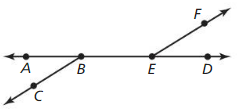
Answer:
Remember the different theorems and postulates discussed in this lesson for proving.
1. Since ∠ABC is supplementary to ∠CBD and ∠CBD is supplementary to ∠DEF, then by congruent supplements theorem, we can say that ∠ABC ≅ ∠DEF
2. Since ∠FEA is supplementary to ∠DEFand ∠DEFis supplementary to ∠CBD, then by congruent supplements theorem, we can say that ∠FEA≅ ∠CBD.
In Exercises 7 – 10. use the diagram and the given angle measure to find the other three measures.
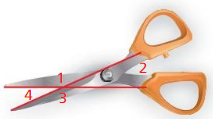
Question 7.
m∠1 = 143°
Answer:
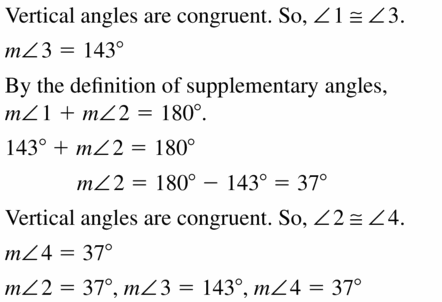
Question 8.
m∠3 = 159°
Answer:
m∠1 = m∠3 , because they are vertical angles.
m∠1 = 159°
m∠2 = 180° – m∠3, because they are supplementary angles
m∠2 = 180° – 159° = 21°
m∠4 = m∠2, because they are vertical angles.
m∠4 = 21°
Question 9.
m∠2 = 34°
Answer:
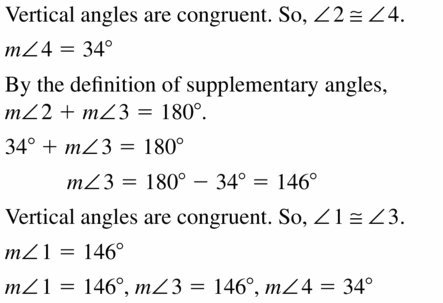
Question 10.
m∠4 = 29°
Answer:
m∠2 = m∠4 , because they are vertical angles.
m∠2 = 29°
m∠1 = 180° – m∠4, because they are supplementary angles
m∠1 = 180° – 29° = 151°
m∠3 = m∠1, because they are vertical angles.
m∠3 = 151°
In Exercises 11 – 14, find the values of x and y.
Question 11.
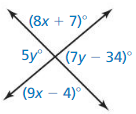
Answer:
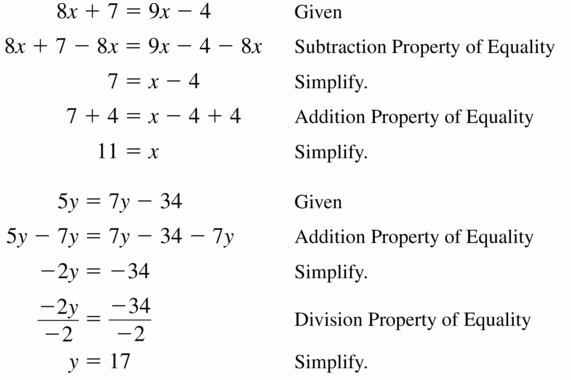
Question 12.
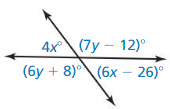
Answer:
4x = 6x – 26
4x – 6x = -26
-2x = -26
x = 26/2
x = 13
7y – 12 = 6y + 8
7y – 6y = 8 + 12
y = 20
Question 13.
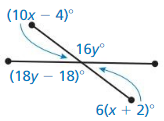
Answer:
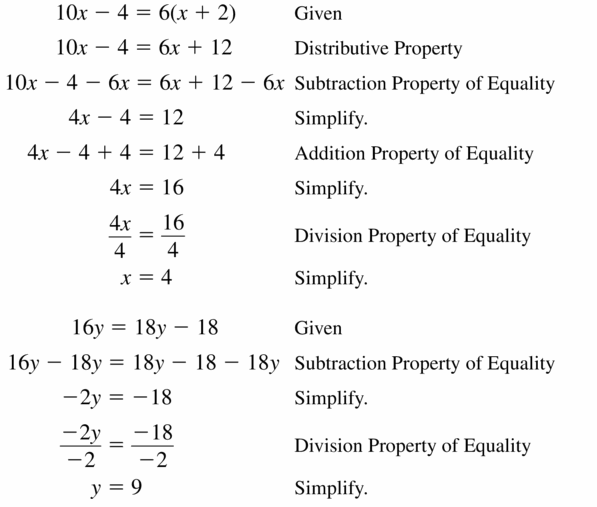
Question 14.

Answer:
2(5x – 5) = 6x + 50
10x – 10 = 6x + 50
10x – 6x = 50 + 10
4x = 60
x = 60/4
x = 15
7y – 9 = 5y + 5
7y – 5y = 5 + 9
2y = 14
y = 14/2
y = 7
ERROR ANALYSIS
In Exercises 15 and 16, describe and correct the error in using the diagram to find the value of x.

Question 15.
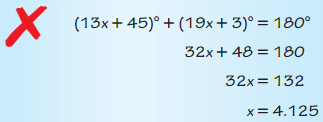
Answer:
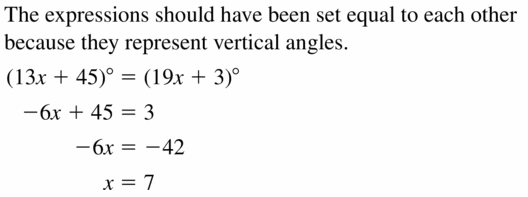
Question 16.
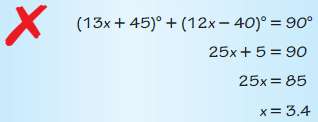
Answer:
Angles they are adding are supplementary, not complementary, so their sum is 180° and not 90°
13x + 45 + 12x – 40 = 180
25x + 5 = 180
25x = 180 – 5
25x = 175
x = 175/25 = 7
x = 7
Question 17.
PROOF
Copy and complete the flowchart proof. Then write a two-column proof.
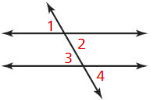
Given ∠1 ≅ ∠3
Prove ∠2 ≅ ∠4

Answer:

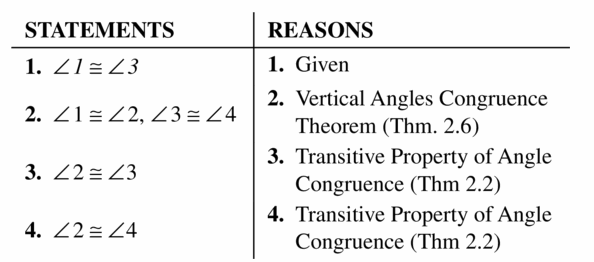
Question 18.
PROOF
Copy and complete the two-column proof. Then write a flowchart proof.
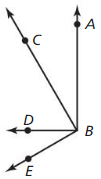
Given ∠ABD is a right angle
∠CBE is a right angle
Prove ∠ABC ≅ ∠DBE
| Statements | Reasons |
| 1. ∠ABD is a right angle.
∠CBE is a right angle. |
1. _____________________________ |
| 2. ∠ABC and ∠CBD are complementary. | 2. Definition of complementary |
| 3. ∠DBE and ∠CBD are complementary | 3. _____________________________ |
| 4. ∠ABE ≅ ∠DBE | 4. _____________________________ |
| Statements | Reasons |
| 1. ∠ABD is a right angle.
∠CBE is a right angle. |
1. Given |
| 2. ∠ABC and ∠CBD are complementary. | 2. Definition of complementary angles |
| 3. ∠DBE and ∠CBD are complementary | 3. Definition of complementary angles |
| 4. ∠ABE ≅ ∠DBE | 4. Congruent Complements Theorem |
Question 19.
PROVING A THEOREM
Copy and complete the paragraph proof be the Congruent Complements Theorem (Theorem 2.5). Then write a two-column proof.

Given ∠1 and ∠2 are complementary
∠1 and ∠3 are complementary
Prove ∠2 ≅ ∠3
∠1 and ∠2 are complementary, and ∠1 and ∠3 are complementary. By the definition
of ____________ angles. m∠1 + m∠2 = 90° and ____________ = 90°. By the ____________ m∠1 + m∠2 = m∠1 + m∠3. By the Subtraction ____________
Property of Equality, ____________ . So. ∠2 ≅∠3 by the definition of ____________ .
Answer:
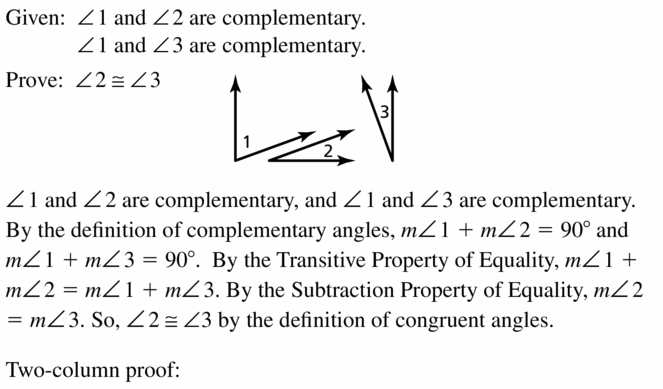
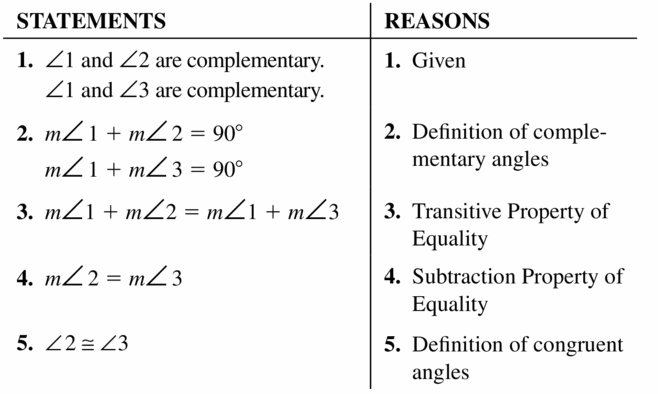
Question 20.
PROVING A THEOREM
Copy and complete the two – column proof for the Congruent Supplement Theorem (Theorem 2.4). Then write a paragraph proof. (See Example 5.)

Given ∠1 and ∠2 are supplementary
∠3 and ∠4 are supplementary
∠1 and ∠4
Prove ∠2 ≅∠3
| Statements | Reasons |
| 1. ∠1 and ∠2 are supplementary ∠3 and ∠4 are supplementary ∠1 ≅ ∠4 |
1. Given |
| 2. m∠1 + m∠2 = 180 m∠3 + m∠4 = 180 |
2. _____________________________ |
| 3. ______________ = m∠3 + m∠4 | 3. Transitive Property of Equality |
| 4. m∠1 = m∠4 | 4. Definition of Congruent angles |
| 5. m∠1 + m∠2 = ___________________ | 5. Substitution property of Equality |
| 6. m∠2 = m∠3 | 6. _____________________________ |
| 7. __________________________ | 7. _____________________________ |
Answer:
| Statements | Reasons |
| 1. ∠1 and ∠2 are supplementary ∠3 and ∠4 are supplementary ∠1 ≅ ∠4 |
1. Given |
| 2. m∠1 + m∠2 = 180° m∠3 + m∠4 = 180° |
2. Definition of Supplementary angles |
| 3. m∠1 + m∠2 = m∠3 + m∠4 | 3. Transitive Property of Equality |
| 4. m∠1 = m∠4 | 4. Definition of Congruent angles |
| 5. m∠1 + m∠2 = m∠3 + m∠1 | 5. Substitution property of Equality |
| 6. m∠2 = m∠3 | 6. Substitution property of Equality |
| 7. ∠2 ≅ ∠3 | 7. Definition of Congruent angles |
PROOF
In Exercises 21 – 24. write a proof using any format.
Question 21.
Given ∠QRS and ∠PSR are supplementary
Prove ∠QRL ≅ ∠PSR
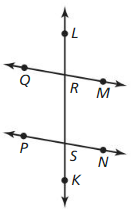
Answer:
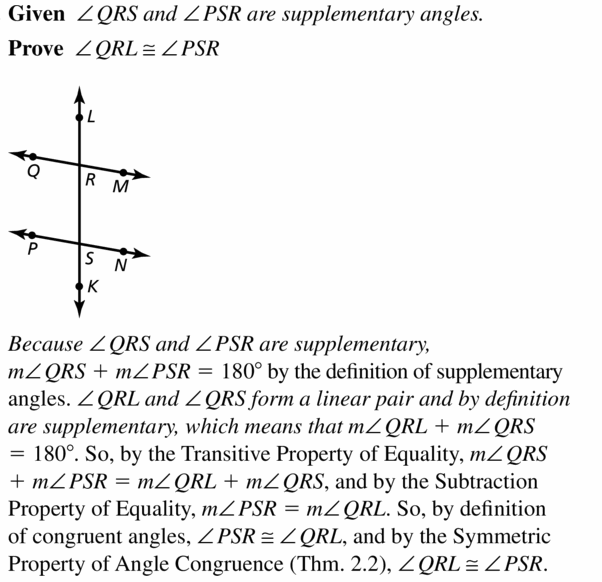
Question 22.
Given ∠1 and ∠3 are complementary.
∠2 and ∠4 are complementary.
Prove ∠1 ≅ ∠4
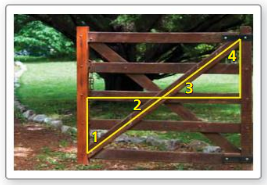
Answer:
Given ∠1 and ∠3 are complementary.
∠2 and ∠4 are complementary.
∠2 ≅ ∠3
m∠1 + m∠3 = 90°
m∠2 + m∠4 = 90°
m∠2 = m∠3
m∠1 + m∠3 = m∠2 + m∠4
m∠1 + m∠2 = m∠2 + m∠4
m∠1 = m∠4
∠1 ≅ ∠4
Question 23.
Given ∠AEB ≅ ∠DEC
Prove ∠AEC ≅ ∠DEB

Answer:
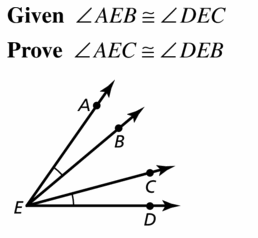
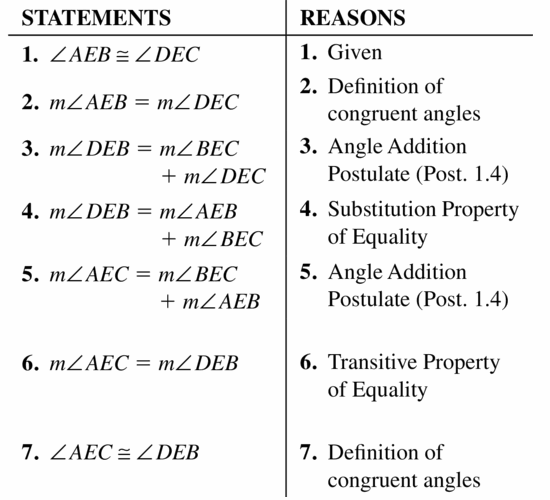
Question 24.


Answer:
\(\overline{J K}\) ⊥ \(\overline{J M}\), \(\overline{K L}\) ⊥ \(\overline{M L}\)
∠J ≅∠M, ∠K ≅∠L
m∠J = 90°
m∠L = 90°
m∠M = m∠J = 90°
m∠K = m∠L = 90°
\(\overline{J M}\) ⊥ \(\overline{M L}\), \(\overline{J K}\) ⊥ \(\overline{K L}\)
Question 25.
MAKING AN ARGUMENT
You overhear your friend discussing the diagram shown with a classmate. Your classmate claims ∠1 ≅∠4 because they are vertical angles Your friend claims they are not congruent because he can tell by looking at the diagram. Who is correct? Support your answer with definitions or theorems.

Answer:

Question 26.
THOUGHT PROVOKING
Draw three lines all intersecting at the same point. Explain how you can give two of the angle measures so that you can find the remaining four angle measures.
Answer:
You need only information about angles ∠1 and ∠2. Then you know measures of their vertical angles.
Full circle has a measure of 360°, so m∠p can be calculated by subtracting 2m∠1 and 2m∠2 from 360° and dividing by 2.
Question 27.
CRITICAL THINKING
Is the converse of the Linear Pair Postulate (Postulate 2.8) true? If so, write a biconditional statement. Explain your reasoning.
Answer:

Question 28.
WRITING
How can you save time writing proofs?
Answer: Remember the different theorems and postulates discussed in this lesson for proving.
Question 29.
MATHEMATICAL CONNECTIONS
Find the measure of each angle in the diagram.

Answer:

Question 30.
HOW DO YOU SEE IT?
Use the student’s two-column proof.
Given ∠1 ≅ ∠2
∠1 and ∠2 are supplementary.
Prove ___________
| Statements | Reasons |
| 1. ∠1 ≅ ∠2 ∠1 and ∠2 are supplementary |
1. Given |
| 2. m∠1 = m∠2 | 2. Definitions of congruent angles |
| 3. m∠1 + m∠2 = 180° | 3. Definition of supplementary angles |
| 4. m∠1 + m∠1 = 180° | 4. substitution property of Equality |
| 5. 2m∠1 = 180° | 5. Simplify |
| 6. m∠1 = 90° | 6. Division Property of Equality |
| 7. m∠2 = 90° | 7. Transitive Property of Equality |
| 8. __________________________ | 8. ________________________________________ |
a What is the student trying to prove?
Answer: Angle 1 and Angle 2 are right angles.
b. Your friend claims that the last line of the proof should be ∠1 ≅ ∠2. because the measures of the angles are both 90°. Is your friend correct? Explain.
Answer: No, because this was one of the given statements.
Maintaining Mathematical Proficiency
Use the cube
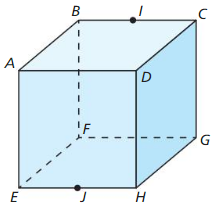
Question 31.
Name three collinear points.
Answer:
![]()
Question 32.
Name the intersection of plane ABF and plane EHG.
Answer:\(\overline{E F}\) is contained in both plane ABF and plane EHG.
Question 33.
Name two planes containing \(\overline{B C}\).
Answer:

Question 34.
Name three planes containing point D.
Answer: Point D is contained in plane ADH, plane CDH, and plane ABC.
Question 35.
Name three points that are not collinear,
Answer:

Question 36.
Name two planes containing point J.
Answer: Point J is contained in plane ADH and plane EFG.
2.4 – 2.6 Performance Task: Induction and the Next Dimension
Mathematical Practices
Question 1.
Explain the purpose of justifying each step in Exercises 5-14 on page 96.
Answer:
The purpose of justifying each step in exercises 5-14 is to learn algebraic properties of equality given below
- Addition Property of Equality
- Subtraction Property of Equality
- Multiplication Property of Equality
- Division Property of Equality
- Substitution Property of Equality
Question 2.
Create a diagram to model each statement in Exercises 5-10 on page 103.
Answer:
Question 3.
Explain why you would not be able to prove the statement in Exercise 21 on page 113 if you were provided with the given information or able to use an postulates or theorems.
Answer:
Reasoning and Proofs Chapter Review
2.1 Conditional Statements
Write the if-then form, the converse, the inverse, the contrapositive. and the biconditional of the conditional statement.
Question 1.
Two lines intersect in a Point.
Answer:
If then form:
If two lines intersect, then the intersection is a point.
Converse:
If the intersection of lines is a point, the two lines intersect.
Inverse:
If two lines do not intersect, then a point is not intersection.
Contrapositive:
If a point is not intersection, then two lines do not intersect.
Biconditional:
Two lines intersect if and only if the intersection is a point.
Question 2.
4x + 9 = 21 because x = 3.
Answer:
If then form:
If x = 3, then 4x + 9 = 21
Converse:
If 4x + 9 = 21, then x = 3
Inverse:
If x ≠ 3, then 4x + 9 ≠ 21
Contrapositive:
If 4x + 9 ≠ 21, then x ≠ 3
Biconditional:
x = 3 if and only if 4x + 9 = 21
Note that x + 3 is hypotesis and 4x + 9 = 21 is conclusion in this sentence.
Question 3.
Supplementary angles sum to 180°.
Answer:
If then form:
If angles are supplementary, then their sum is 180°.
Converse:
If the sum of angles is 180°, then these angles are supplementary.
Inverse:
Contrapositive:
If angles are not supplementary, then these angles are not supplementary.
Biconditional:
Angles are supplementary if and only if then their sum is 180°
Question 4.
Right angles are 90°.
Answer:
If then form:
Angles are right if and only if then its measure is 90°
Converse:
If the measure of angles is 90°, then these angles are right.
Inverse:
If angles are not right, then these angles are not 90°.
Contrapositive:
If the measure of angles is not 90°, then these angles are not right.
Biconditional:
Angle is right if and only if its measure is 90°.
2.2 Inductive and Deductive Reasoning
Question 5
conclusion can you make about the difference of any two odd integers?
Answer:
Look for a pettern in several examples:
3 – 1 = 2
-3 – 5 = -8
9 – 11 = -2
15 – 31 = -16
Step 2:
Let m, n be any two intergers.
2m + 1 and 2n + 1 are odd intergers because 2m and 2n are even integers.
2m + 1 – (2n + 1) = 2m + 1 – 2m – 1
= 2m – 2n
= 2(m – n)
2(m – n) is even number.
Question 6.
What conclusion can you make about the product of an even and an odd integer?
Answer:
Look for a pettern in several examples:
2 . 1 = 2
3 . 6 = 18
10 . 5 = 50
Product of an even and an odd interger is even interger.
Let m, n be any two intergers.
2m is even and 2n + 1 odd integer
2m . (2n + 1) = 4mn + 2m
2(2mn + m) is even number.
Question 7.
Use the Law of Detachment to make a valid conclusion.
If an angle is a right angle, then the angle measures 90°. ∠B is a right angle.
Answer:
m∠B = 90°
Law of detachment:
If a, then b
a is true
Conclusion: b is true
Question 8.
Use the Law of Syllogism to write a new conditional statement that follows from the pair of true statements: If x = 3, then 2x = 6. If 4x = 12. then x = 3.
Answer:
Law of detachment:
If a, then b
If b, then c
Conclusion: If a, then c
Conclusion of one conditional statement must be bypotesis of another.
if 4x = 12 then 2x = 6
2.3 Postulates and Diagrams
Use the diagram at the right to determine whether you can assume the statement.

Question 9.
Points A, B, C, and E are coplanar.
Answer: Points lie on two parallel lines, meaning that they lie in same plane, so ther are coplanar.
Question 10.
![]()
Answer: Question 10.
![]()
Answer:
![]() are perpendicular because it is given on graph that angle ∠HCE is right angle.
are perpendicular because it is given on graph that angle ∠HCE is right angle.
Question 11.
Points F, B, and G are collinear.
Answer:
We cannot assume this statement, because we cannot see from the graph if the line \(\overline{B G}\) goes through point F. so we cannot conclude whether these points are collinear.
Question 12.
![]()
Answer:
Since point lies G lies on \(\overline{C E}\), \(\overline{A B}\) must also be parallel with \(\overline{G E}\), because \(\overline{C E}\) and \(\overline{G E}\) are the same lines.
sketch a diagram of the description.
Question 13.
∠ABC, an acute angle, is bisected by ![]() .
.
Answer:
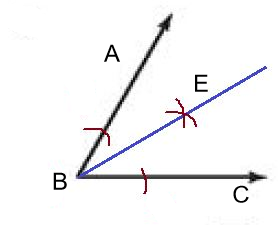
The compass is opened to a certain length and its fixed end of the compass is placed on B and two arcs are made on both if the given lines, subtending the given angle. Without changing this length, the fixed point is placed on A and a third arc is draw. Then the fixed point is placed on B and a fourth arx is shown. These arcs should intersect at a certain point, here shown by the point E. Join E and B to form the line BE which bisects the given angle into 2 equal halves.
Question 14.
∠CDE, a straight angle, is bisected by ![]() .
.
Answer:
The line DK is the angle bisector of ∠CDE. Since ∠CDE is a straight angle, DK can also be called its perpendicular bisector.
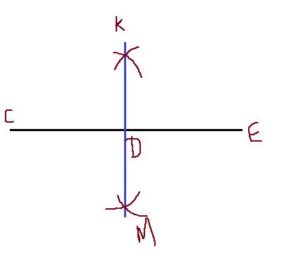
Question 15.
Plane P and plane R intersect perpendicularly in ![]() . \(\overline{Z W}\) lies in plane P
. \(\overline{Z W}\) lies in plane P
Answer:
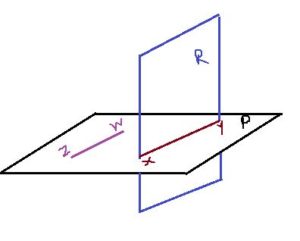
2.4 Algebraic Reasoning
Solve the equation. Justify each step.
Question 16.
– 9x – 21 = – 20x – 87
Answer:
– 9x – 21 = – 20x – 87
Add 21 on both sides
– 9x – 21 + 21 = – 20x – 87 + 21
-9x = -20x – 66
-9x + 20x = -66
11x = -66
x = -66/11
x = -6
Question 17.
15x + 22 = 7x + 62
Answer:
15x + 22 = 7x + 62
15x – 7x = 62 – 22
8x = 40
x = 40/8
x = 5
Question 18.
3(2x + 9) = 30
Answer:
3(2x + 9) = 30
2x + 9 = 30/3
2x + 9 = 10
2x = 10 – 9
2x = 1
x = 1/2
Question 19.
5x + 2(2x – 23) = – 154
Answer:
5x + 2(2x – 23) = – 154
5x + 4x – 46 = – 154
9x – 46 = -154
9x = -154 + 46
9x = -108
x = -108/9
x = -12
Name the property of equality that the statement illustrates.
Question 20.
If LM = RS and RS = 25, then LM = 25.
Answer:
This is the illustration of Transitive property of equality
If a = b and b = c then a = c
Question 21.
AM = AM
Answer:
This is the illustration of the Reflexive property of equality
a = a
2.5 Proving Statements about Segments and Angles
Name the property that the statement illustrates.
Question 22.
If ∠DEF ≅∠JKL, then ∠JKL ≅ ∠DEF
Answer:
This is the illustration of Symmetric property of Angle Congruence.
Symmetric property of Angle Congruence
If ∠1 ≅ ∠2, then ∠2 ≅ ∠1
Question 23.
∠C ≅ ∠C
Answer:
This is the illustration of Reflexive property of Angle Congruence.
Reflexive property of Angle Congruence
∠1 ≅ ∠1
Question 24.
If MN = PQ and PQ = RS. then MN = RS.
Answer:
Transitive Property of Segment Congruence
Question 25.
Write a two-column proof be the Reflexive Property of Angle Congruence (Thm. 2.2).
Answer:
Given
An angle with vertex A exists.
m of angle A = m of the angle with vertex A
m of angle A = m of angle A
angle A is congruent to angle A.
2.6 Proving Geometric Relationships
Question 26.
Write a proof using any format
Given ∠3 and ∠2 are complementary.
m∠1 + m∠2 = 90°
Prove ∠3 ≅∠1
Answer:
Given ∠3 and ∠2 are complementary.
m∠1 + m∠2 = 90°
m∠3 + m∠2 = 90°
m∠1 + m∠2 = m∠3 + m∠2
m∠1 = m∠3
∠1 ≅∠3
Reasoning and Proofs Test
Use the diagram to determine whether you can assume the statement.
Explain your reasoning.
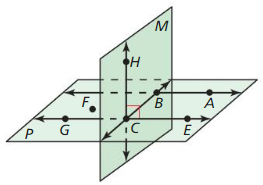
Question 1.
![]() ⊥ plane M
⊥ plane M
Answer:
Since there are no indications that of a right angle being formed between ![]() and plane M, then we cannot assume the statement.
and plane M, then we cannot assume the statement.
Question 2.
Points F, G, and A are coplanar.
Answer:
Points F, G and A lie on parallel lines, so they must be coplanar.
Question 3.
Points E, C, and G are collinear.
Answer: Points E, C, and G lie on same line, so by definition, they are collinear.
Question 4.
Planes M and P intersect at ![]() .
.
Answer: Intersection of planes P and M contains line ![]() Since the intersection of planes is a line, then intersection of planes P and M
Since the intersection of planes is a line, then intersection of planes P and M ![]()
Question 5.
![]() lies in plane P.
lies in plane P.
Answer: ![]() must lie in plane P because points F and A lie in plane P.
must lie in plane P because points F and A lie in plane P.
Question 6.
![]()
Answer: You cannot see if ![]() because line \(\overline{F G}\) is not drawn.
because line \(\overline{F G}\) is not drawn.
Solve the equation. Justify each step.
Question 7.
9x + 31 = – 23 + 3x
Answer:
9x + 31 = – 23 + 3x
9x – 3x = -23 – 31
6x = -54
x = -54/6
x = -9
Question 8.
26 + 2(3x + 11) = – 18
Answer:
Given,
26 + 2(3x + 11) = – 18
26 + 6x + 22 = -18
6x + 48 = -18
6x = -18 – 48
6x = -66
x = -66/6
x = -11
Question 9.
3(7x – 9) – 19x – 15
Answer:
Given,
3(7x – 9) – 19x = – 15
21x – 19x = – 15 + 27
2x = 12
x = 12/2
x = 6
Write the if-then form, the converse, the inverse, the contrapositive. and the biconditional of the conditional statement.
Question 10.
Two planes intersect at a line.
Answer:
If then form:
If two planes intersect, then the intersection is a line.
Converse:
If the intersection of two objects is a line, then the objects that intersect are planes.
Inverse:
If two planes do not intersect, then a line is not intersection.
Contrapositive:
If the intersection of two object is not a line, then the objects that intersect are not planes.
Biconditional:
Two planes intersect if and only if the intersection is a line.
Question 11.
A relation that pairs each input with exactly one output is a function.
Answer:
If then form:
If a relation pairs each input with exactly one output, then that relation is a function.
Converse:
If a relation is a function, then it pairs each input with exactly one output.
Inverse:
If a relation does not pairs each input with exactly one output, then that relation is not a function.
Contrapositive:
If a relation is not a function, then it does not pairs each input with exactly one output.
Biconditional:
A relation is function if and only if it pairs each input with exactly one output.
Use inductive reasoning to make a conjecture about the given quantity. Then use deductive reasoning to sIm that the conjecture is true.
Question 12.
the sum of three odd integers
Answer:
1 + 3 + 7 = 11
The sum of three odd integers is odd integer.
Question 13.
the product of three even integers
Answer:
2 × 2 × 4 = 16
Thus the product of three even integers is even integer.
Question 14.
Give an example of two statements for which the Law of Detachment does not apply.
Answer:
Law of Detachment
If a, then b
a is true
Conclusion: b is true
Example:
If two angles are vertical, then they are congruent.
Two angles are congruent.
We cannot use law of detachment because the conclusion of the conditional statement is given true, not the hypotesis.
If two angles are right and supplementary, then they are congruent.
Two angles are congruent.
We cannot use law of detachment because the conclusion of the conditional statement is given true, not the hypotesis.
Question 15.
The formula for the area A of a triangle is A = \(\frac{1}{2}\)bh, where b is the base and h is the height. Solve the formula for h and justify each step. Then find the height of a standard yield sign when the area is 558 square inches and each side is 36 inches.
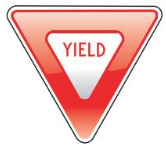
Answer:
Given,
A = \(\frac{1}{2}\)bh
where b is the base and h is the height
2A = bh
h = 2A/b
h = 2(558)/36
h – 31
Question 16.
You visit the zoo and notice the following
- The elephants, giraffes, lions, tigers, and zebras are located along a straight walkway.
- The giraffes are halfway between the elephants and the lions.
- The tigers are halfway between the lions and the zebras.
- The lions are hallway between the giraffes and the tigers.
Draw and label a diagram that represents this information. Then prove that the distance between the elephants and the giraffes is equal to the distance between the tigers and the zebras. Use any proof format.
Answer:
Diagram according to the given conditions. The blue line shows each enclosure and the labeled alphabets are the endpoint of the front of each enclosure and respective seperation:

Distance between the elephants and the giraffes is equal to BC and that between tigers as zebras if HI.
Here BD = HI according to the given conditions.
Question 17.
Write a proof using an format.
Given ∠2 ≅∠3
\(\vec{T}\)V bisects ∠UTW.
Prove ∠1 ≅ ∠3
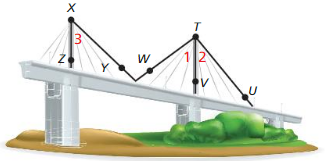
Answer:
Given ∠2 ≅∠3
\(\vec{T}\)V bisects ∠UTW.
∠1 ≅ ∠2
Transitive property of Angle Congruence.
∠1 ≅ ∠3
Reasoning and Proofs Cumulative Assessment
Question 1.
Use the diagram to write an example of each postulate.
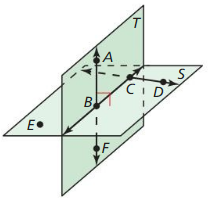
a. Two Point Postulate (Postulate 2.1): Through any two points, there exists exactly one line.
Answer:
Read the different postulates and use the diagram to look for an example for each postulate.
Passing through two points, A and F there exists exactly one line which is \(\overline{A F}\)
b. Line Intersection Postulate (Postulate 2.3): If two lines intersect, then their intersection is exactly one point.
Answer: \(\overline{B C}\) intersects \(\overline{C D}\) at exactly one point which is point C.
c. Three Point Postulate (Postulate 2.4): Through any three noncollinear points, there exists exactly one plane.
Answer:
Points E, B, C there exists exactly one plane which is plane S.
d. Plane-Line Postulate (Postulate 2.6): If two points lie in a plane, then the line containing them lies in the plane.
Answer: Points A and F lies in plane T, therefore \(\overline{A F}\) also lies in the plane T.
e. Plane Intersection Postulate (Postulate 2.7): If two planes intersect, then their intersection is a line
Answer: Planes S and T at \(\overline{B C}\)
Question 2.
Enter the reasons in the correct positions to complete the two-column proof.
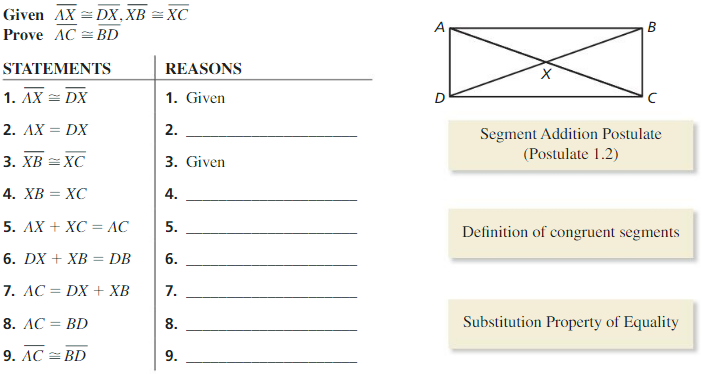
Answer:
2. AX = DX according to definition of congruent segments.
4. XB = XC according to definition of congruent segments.
5. AX + XC = AC according to segment addition postulate.
6. DX + XB = DB according to segment addition postulate.
7. AC = DX + XB according to substitution property of equality.
8. AC = BD according to substitution property of equality.
9. \(\overline{A C}\) = \(\overline{B D}\) according to substitution property of equality and definition of congruent segments.
Question 3.
Classify each related conditional statement. based on the conditional statement
“If I study, then I will pass the final exam.”
a. I will pass the final exam if and only if I study.
Answer: biconditional statement
b. If I do not study, then I will not pass the final exam.
Answer: inverse
c. If I pass the final exam, then I studied.
Answer: converse
d. If I do not pass the final exam, then I did not study.
Answer: contrapositive
Question 4.
List all segment bisectors given x = 3.

Answer:
Remember that a segment bisector divides a segment into two equal parts.
\(\overline{A B}\) = x + 1 = (3) + 1 = 4
\(\overline{B C}\) = 6(4 – x) = 6(4 – (3)) = 6(1) = 6
\(\overline{C D}\) = 4x – 6 = 4(3) – 6 = 12 – 6 = 6
\(\overline{D E}\) = 2(5x – 7) – 8 = 2(5(3) – 7) – 8
= 2(8) – 8 = 8
\(\overline{E F}\) = 3(5 – x) + 2 = 3(5 – 3) + 2 = 6 + 2 = 8
Line l bisects \(\overline{B D}\)
Line n bisects \(\overline{D F}\)
Line m bisects \(\overline{A F}\)
Question 5.
You are given m∠FHE = m∠BHG = m∠AHF = 90°. Choose the symbol that makes each statement true. State which theorem or postulate. if any, supports your answer.

= ≅ ≠
a. ∠3 _____ ∠6
Answer: ∠3 = ∠6 as they are vertically opposite angles.
b. m∠4 ______ m∠7
Answer: m∠4 = m∠7 as they are vertically opposite angles.
c. m∠FHE _______ m∠AHG
Answer: m∠FHE ≠ m∠AHG as ∠FHE is a right angle while ∠AHG is an acute angle.
d. m∠AHG + m∠GHE _______180°
Answer: m∠AHG + m∠GHE = 180° as m∠AHG and m∠GHE are supplementary angles lying on the straight line AHE.
Question 6.
Find the distance between each pair of points. Then order each line
segment from longest to shortest.
a. A(- 6, 1), B(- 1, 6)
Answer:
d = √(x2 – x1)² + (y2 – y1)²
AB = √(-1 – (-6))² + (6 – 1)² = 5√2 = 7.071
b. C(- 5, 8), D(5, 8)
Answer:
AB = √(5 – (-5))² + (8 – 8)² = √100 = 10
c. E(2, 7), F(4, – 2)
Answer:
EF = √(4 – (2))² + (-2 – 7)² = √85 = 9.22
d. G(7, 3), H(7, – 1)
Answer:
GH = √(7 – 7)² + (-1 – 3)² = √16 = 4
e. J(- 4, – 2), K(1, – 5)
Answer:
JK = √(1 – (-4))² + (-5 – (-2))² = √34 = 5.83
f. L(3, – 8), M(7, – 5)
Answer:
LM = √(7 – 3)² + (-5 – (-8))² = √25 = 5
Question 7.
The proof shows that ∠MRL is congruent to ∠NSR. Select all other angles that are also congruent to ∠NSR.
Given ∠MRS and ∠NSR are supplementary.
Prove ∠MRL ≅ ∠VSR
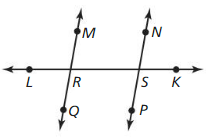
| Statements | Reasons |
| 1. ∠MRS and ∠NSR are supplementary | 1. Given |
| 2. ∠MRL and ∠MRS are a linear pair. | 2. Definition of linear pair, as shown in the diagram |
| 3. ∠MRL and ∠MRS are supplementary. | 3. Linear Pair Postulate (Postulate 2.8) |
| 4. ∠MRL ≅ ∠NSR | 4. Congruent Supplements Theorem (Theorem 2.4) |
∠PSK ∠KSN ∠PSR ∠QRS ∠QRL
Answer:
1. ∠MRL and ∠QRS are vertical angles so by the vertical angles congruence theorem, we can say that ∠MRL ≅ ∠QRS
2. ∠NSR and ∠PSR are vertical angles so by the vertical angles congruence theorem, we can say that ∠NSR ≅ ∠PSR
3. Because ∠MRL ≅ ∠NSR based on the proof by Transitive Property of angles congruence, we can say that ∠NSR ≅ ∠QRS
Question 8.
Your teacher assigns your class a homework problem that asks you to prove the Vertical Angles Congruence Theorem (Theorem 2.6) using the picture and information given at the right. Your friend claims that this can be proved without using the Linear Pair Postulate (Postulate 2.8). Is our friend correct? Explain your reasoning.
Given ∠1 and ∠3 arc vertical angles.
Prove ∠1 ≅ ∠3

Answer:
Your friend is incorrect because in order to prove vertical angles congruence theorem, you need to state that ∠1 forms a linear pair with ∠2 and ∠3 with ∠2.
With this, you can state that each of those two angles are supplementary to ∠2 using the linear pair postulate. From here ∠1 and ∠3 are congruent because of the congruent supplements theorem.
